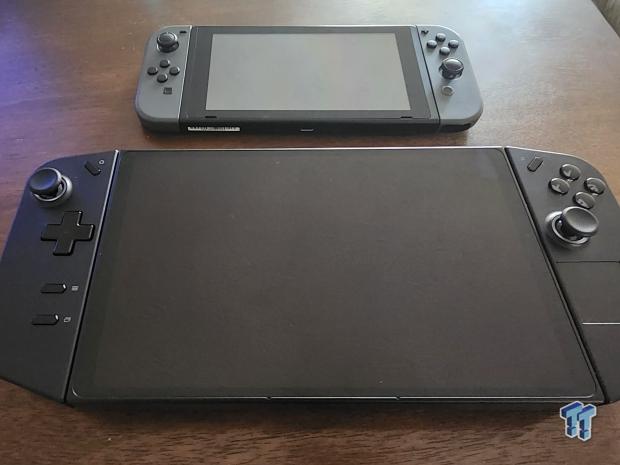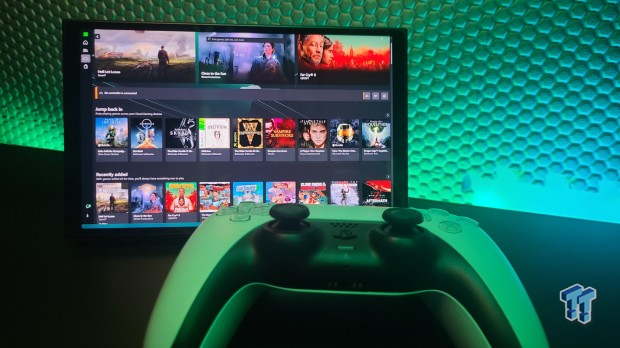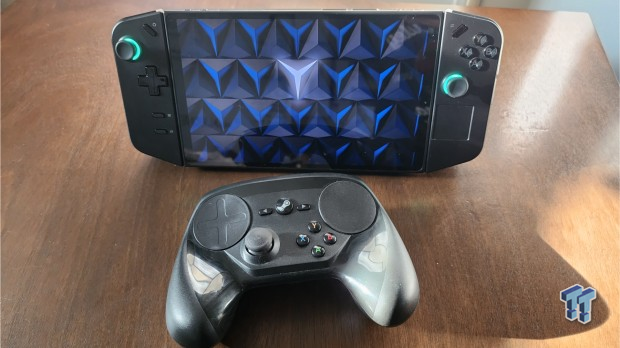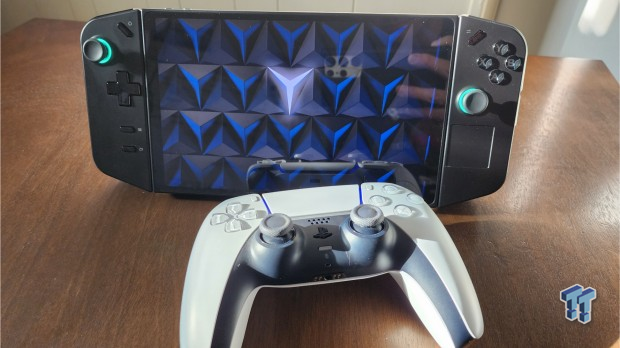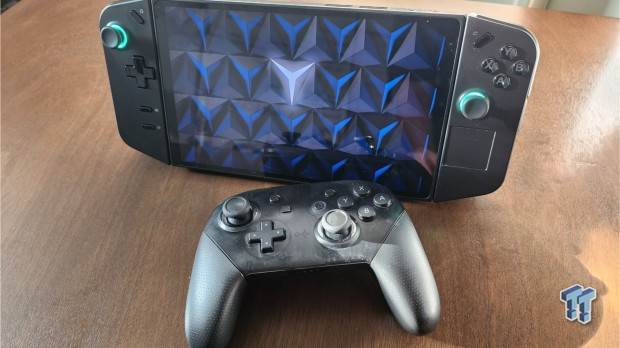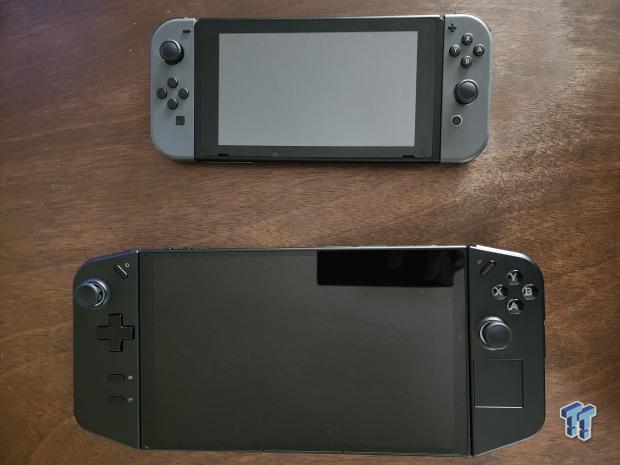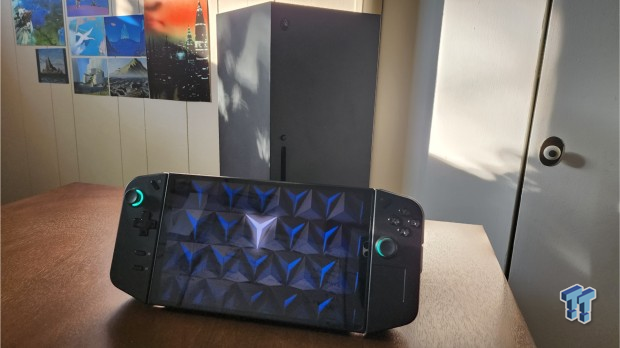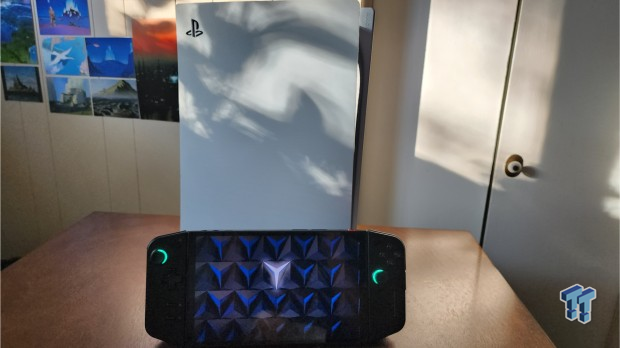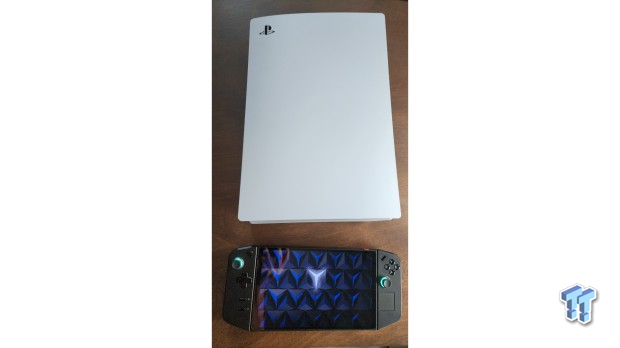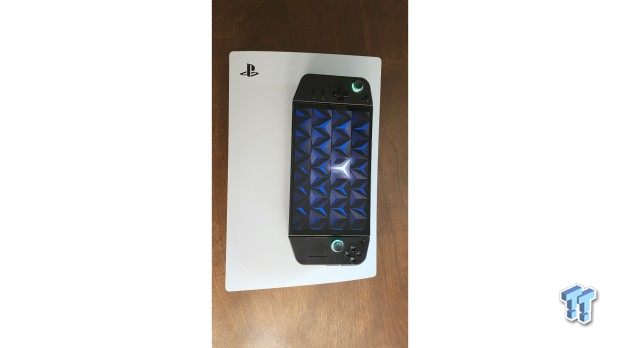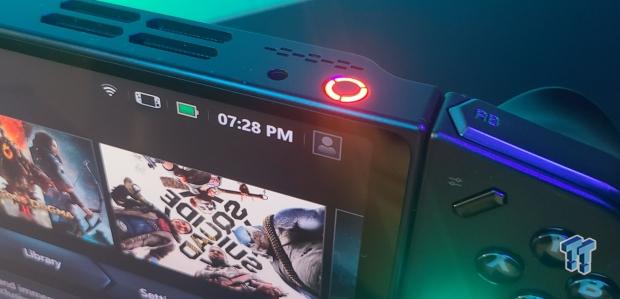
The Bottom Line
Pros
- + Decent on-the-go performance
- + Fantastic controllers
- + Vivid, large screen
- + Quick-launch UI buttons are convenient
Cons
- - Software and driver issues
- - Minor gripes with UI/OS
Should you buy it?
AvoidConsiderShortlistBuyIntro
- Manufacturer - Lenovo
- Release Date - October 31, 2023
- MSRP - $699 (512GB model), $749 (1TB model, reviewed)
- Device Type - PC gaming handheld
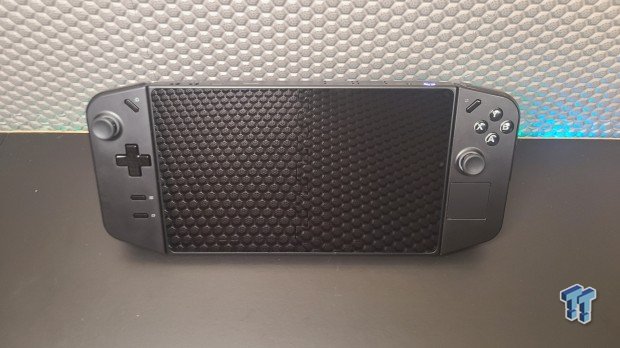
The Lenovo Legion Go is an innovative handheld that packs a serious hardware punch. On the surface, the Legion Go is like a supercharged Nintendo Switch. It has two controller halves split by a screen for flexible on-the-go play, offering things like tabletop gaming.
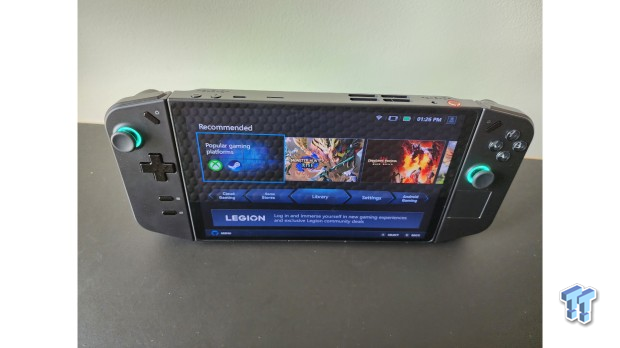
The Legion Go's secret sauce is a combination of performance, functionality, and customization. It's a very balanced machine that puts a PC in your backpack. Lenovo's handheld is a convergence of innovations in hardware, software, and user experience, offering decent PC gaming in a high-quality package that's fun to use.
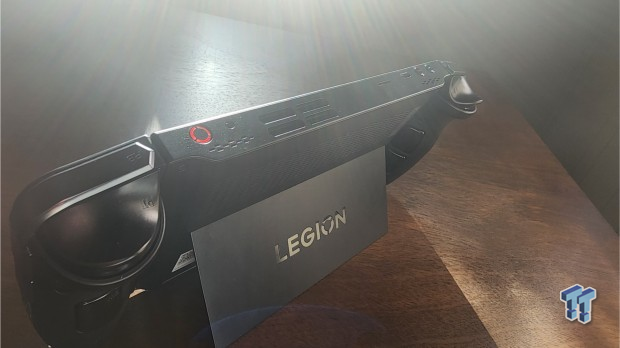
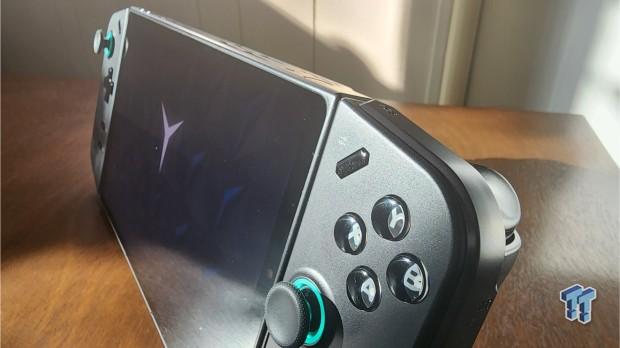

Lenovo Legion Go 8.8' 144Hz WQXGA Handheld Touchscreen Gaming PC
Specifications
Lenovo Legion Go Specifications
- Processor: AMD Ryzen™ Z1 Extreme Processor (3.30 GHz up to 5.10 GHz)
- Operating System: Windows 11 Home 64
- Graphics: Integrated AMD Radeon™ Graphics
- Memory: 16 GB LPDDR5X-7500MHz (Soldered)
- Storage: 512 GB /1TB SSD M.2 2242 PCIe Gen4 TLC
- Display: 8.8" QHD (2560 x 1600), IPS, Touchscreen, 97%DCI-P3, 500 nits, 144Hz
- Screen Resolution: 2560 x 1600
- Touch Screen: Touch
- Weight: Starting at .65kg / 1.41lbs
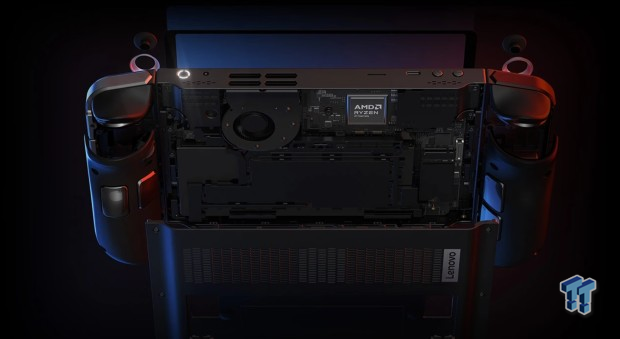
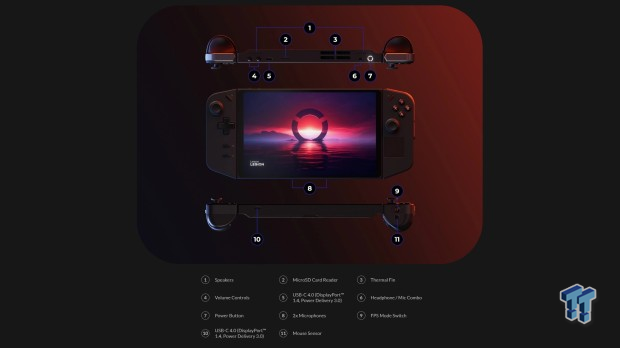
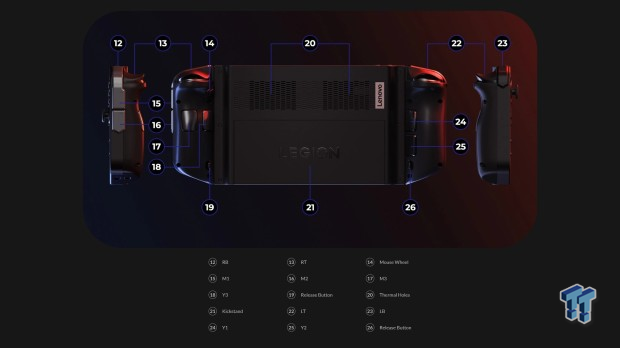
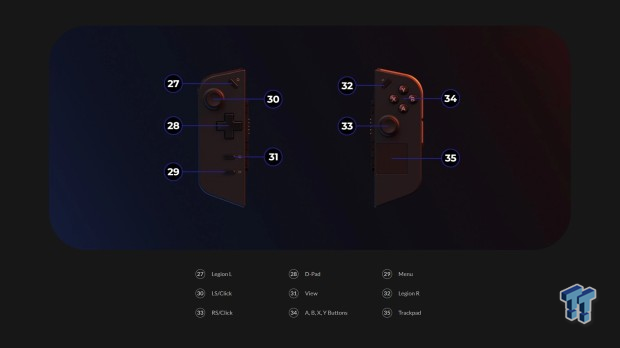
Performance Tests - Resolution & FPS
While this is indeed a device aimed at enthusiasts, you shouldn't expect enthusiast-level performance from the Legion Go's onboard AMD Z1 Extreme SoC. Game performance is variable, but on average, the handheld delivered its best results in the Performance mode presets.
Combining the Quiet x Efficiency TDP and OS Modes should be avoided at all costs if you care about frame rate--otherwise, you want to go all-in on Performance mode. Sure, you'll sacrifice battery, but it's ultimately worth it.
We tested 5 games in total on the Legion Go, including:
- Far Cry 6 (Benchmark tool)
- Metro Last Light (Benchmark tool)
- Plague Tale Requiem (Cap Frame X)
- Shadow of the Tomb Raider (Benchmark tool)
- Starfield (Cap Frame X)
Each game is run through six separate passes with different combinations of TDP Mode and OS Mode configs, as well as varying resolutions. The games captured using CapFrameX were done in 15-minute increments.
Far Cry 6
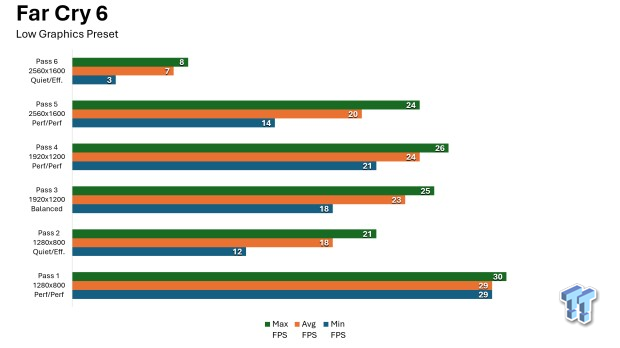
Far Cry 6 is one of the more demanding games that we tested, and the performance wasn't so great on the Legion Go. At 1280x800 resolution at low graphics preset settings, I would get around 30 FPS in Far Cry 6 with the performance modes active. That being said, the gameplay still looked decent at 1280 res, and I actually enjoyed the experience quite a bit despite the lower-end visuals.
Pass 1 - 1280 x 800
- TDP Mode - Performance
- OS Mode - Performance
Frame rates capped out at 30FPS, but the minimum FPS was around 29FPS. The game didn't look fantastic, but the visuals were still playable. Just don't expect to get good res/perf from this game.
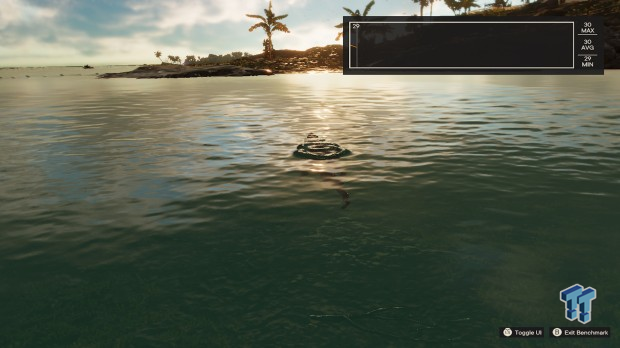
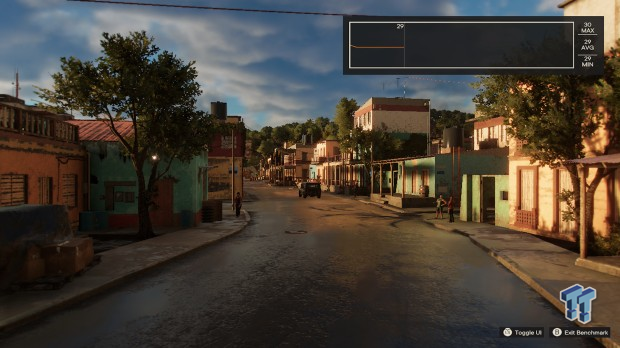
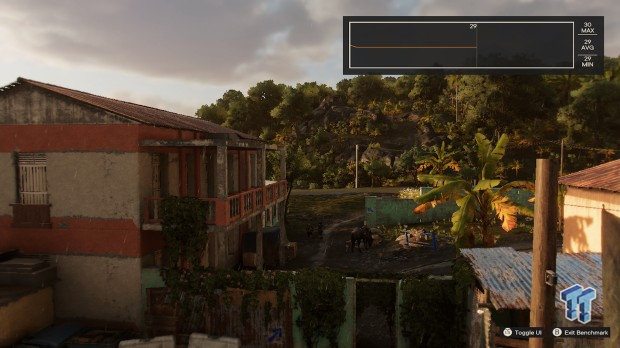
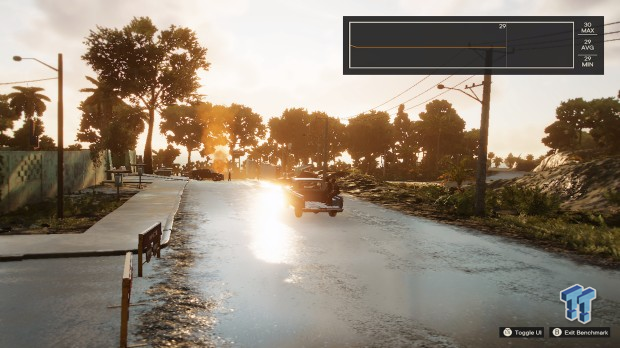
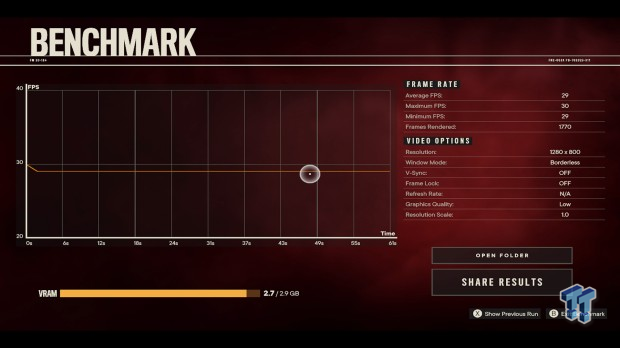
Pass 2 - 1280 x 800
- TDP Mode - Quiet
- OS Mode - Efficiency
A trend that we'll see throughout testing is that the Quiet x Efficiency mode combinations are not ideal for gaming. That was the case here, where the game delivered a huge FPS range between 12-21 frames per second mark at low settings.
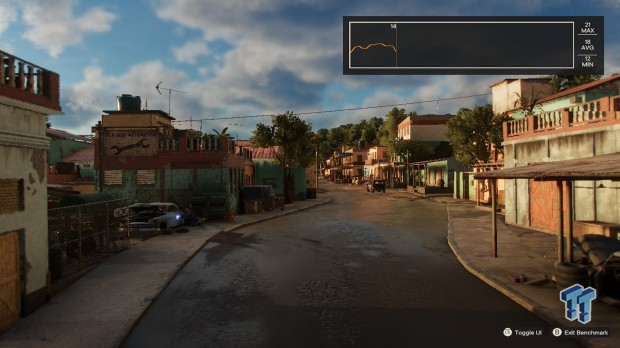
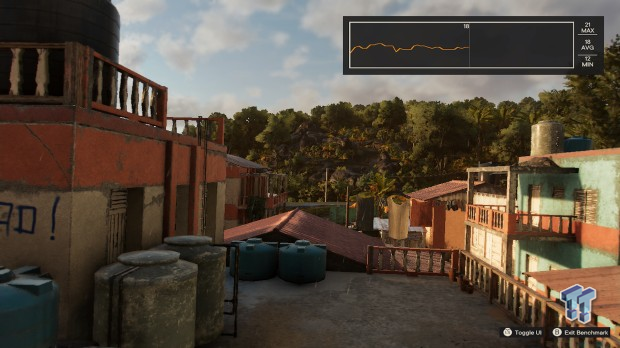
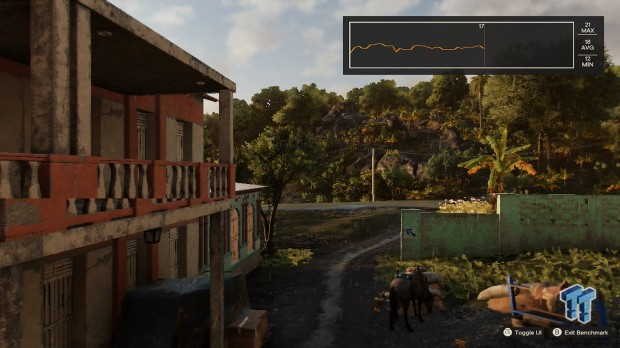
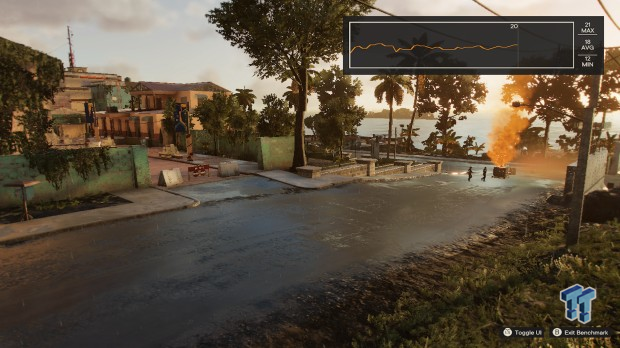
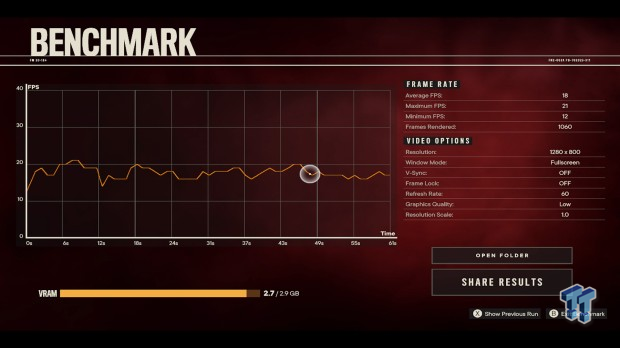
Pass 3 - 1920 x 1200
- TDP Mode - Balanced
- OS Mode - Balanced
FPS was around 23 frames per second at 1920 x 1200 in the Balanced preset. These modes are more designed to sit in the middle of perf vs battery life.
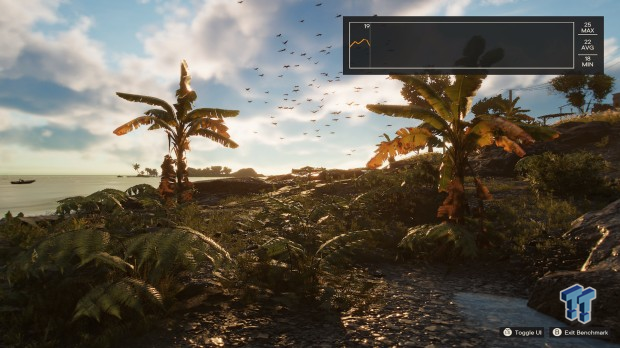
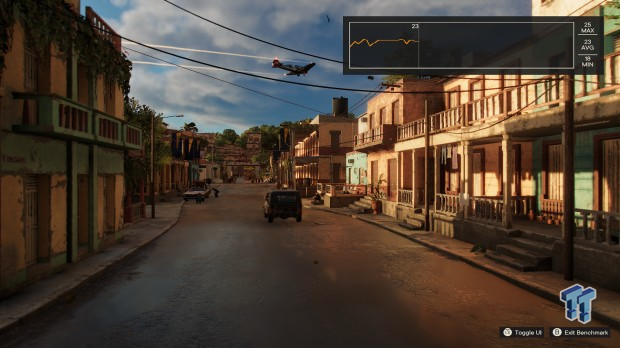
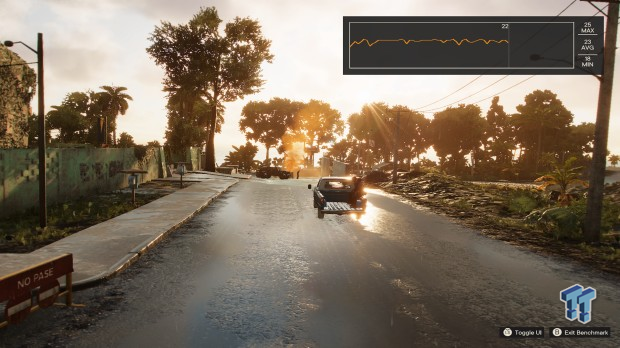
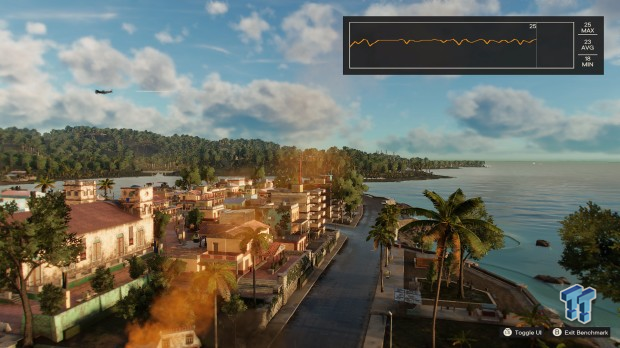
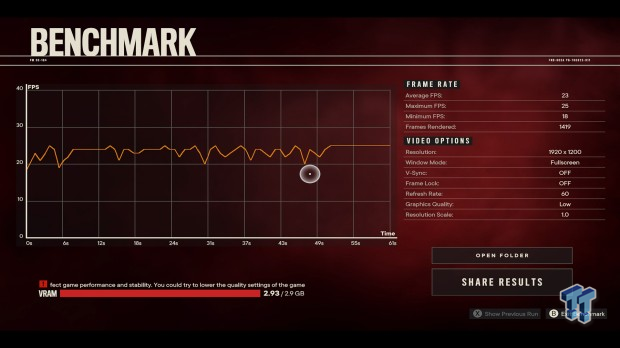
Pass 4 - 1920 x 1200
- TDP Mode - Performance
- OS Mode - Performance
FPS got a slight bump to 24 average FPS and 26 max FPS, and the graphics weren't so bad either.
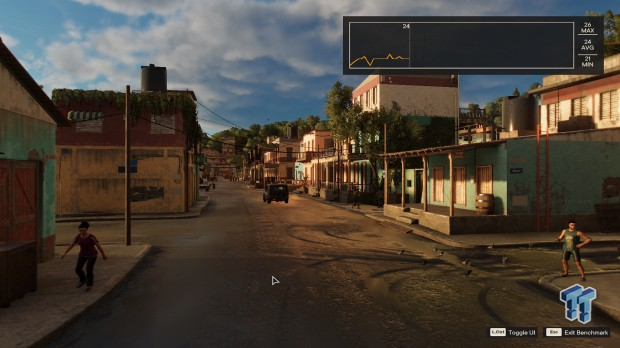
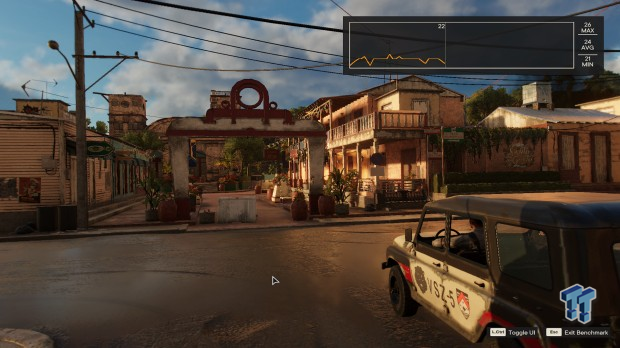
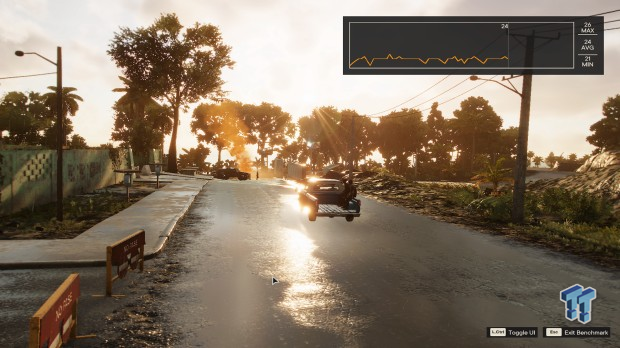
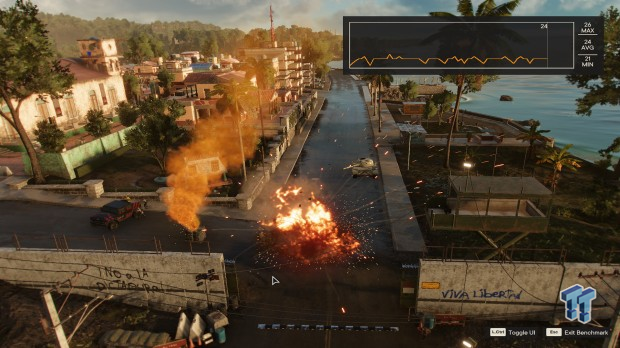
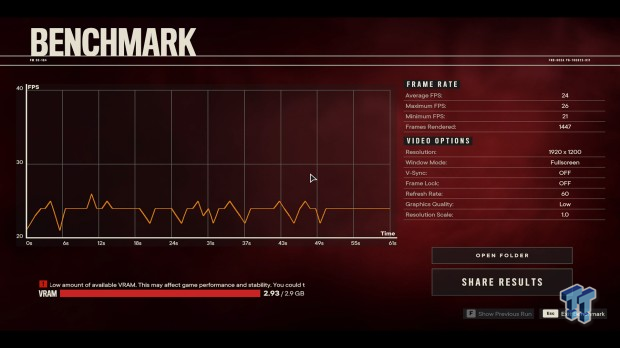
Pass 5 - 2560 x 1600
- TDP Mode - Performance
- OS Mode - Performance
The benchmark tool warned me that 2560x1600 resolution would exceed the Legion Go's available 2.9GB of VRAM memory, and performance suffered quite a bit as a result. FPS dropped as low as 14 and bumped as high as 24.
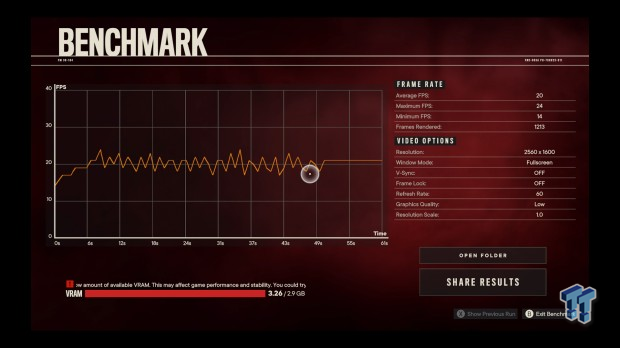
Pass 6 - 2560 x 1600
- TDP Mode - Quiet
- OS Mode - Efficiency
Predictably, Far Cry 6 ground to a FPS-crunching halt during this test. The benchmark tool exceeded VRAM thresholds by 360MB, and the game ranged from 3-7 FPS in the efficiency modes.
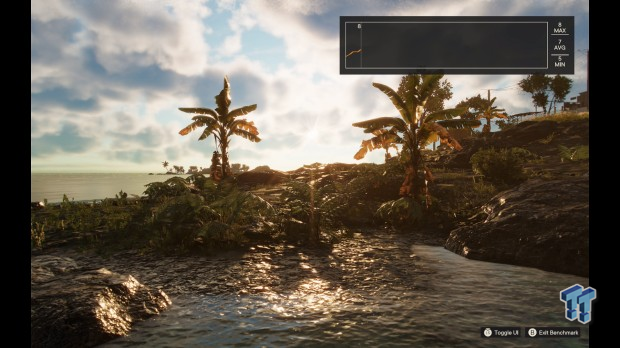
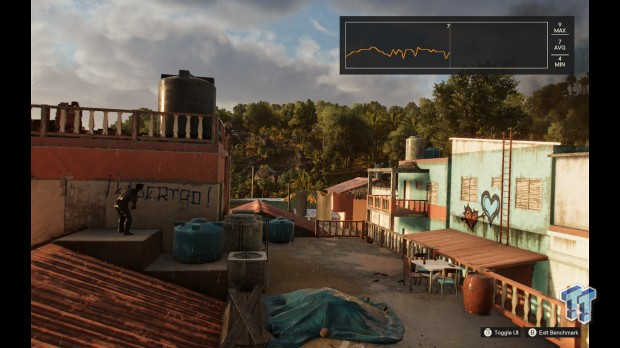
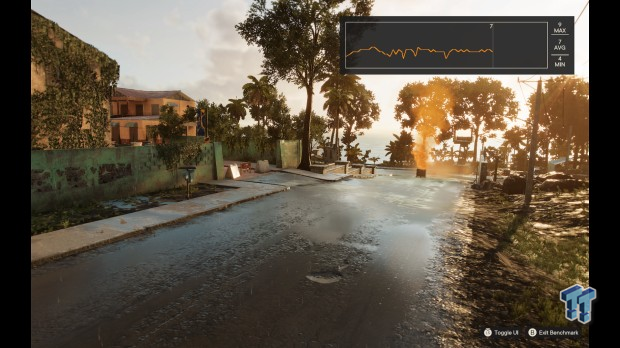
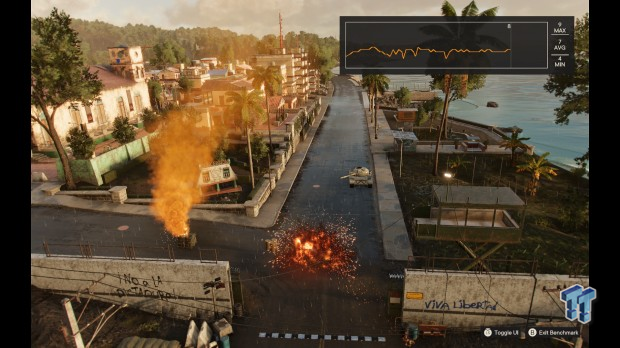
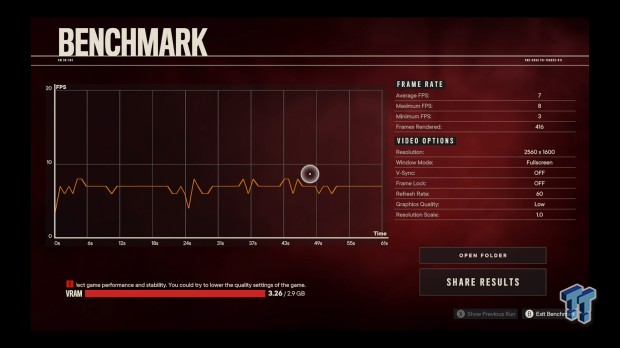
Metro: Last Light
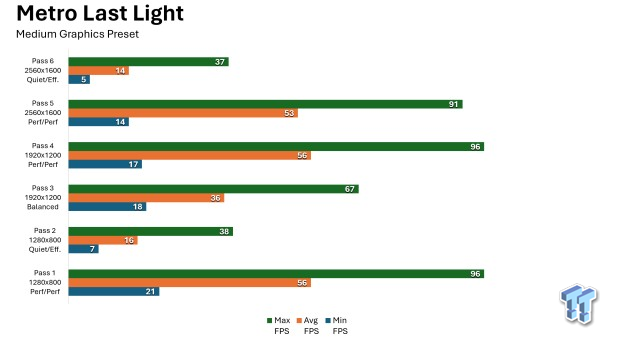
Metro Last Light plays very well on the Legion Go, provided you avoid the Quiet x Efficiency settings combination. I was actually impressed at the FPS I was getting. The results were conducted with the Medium graphics preset enabled.
Pass 1 - 1280 x 800
- TDP Mode - Performance
- OS Mode - Performance
This is where Metro really shined on the Legion Go. Just low resolution, low settings, and high FPS. Frame rates ranged from 56-95 FPS here.
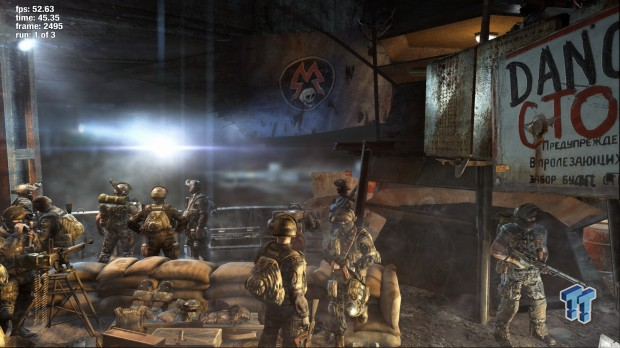
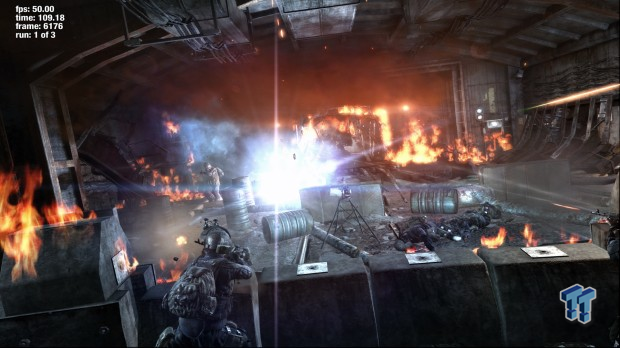
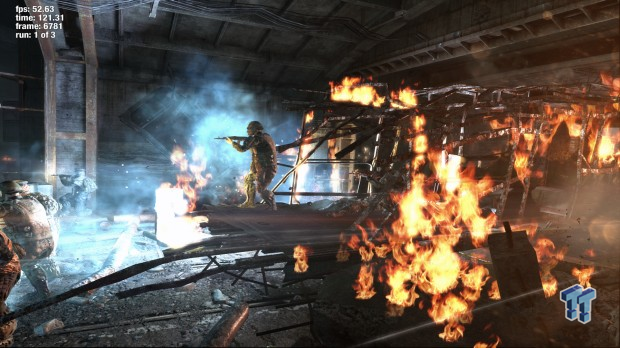
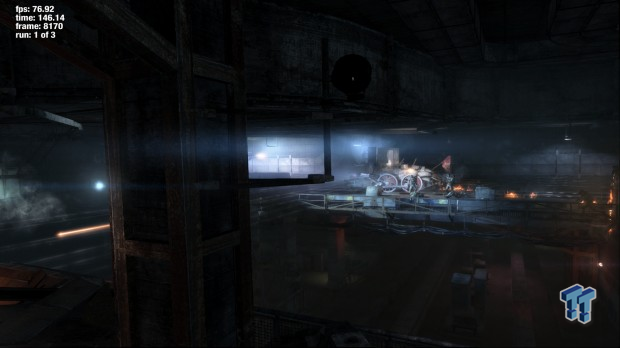
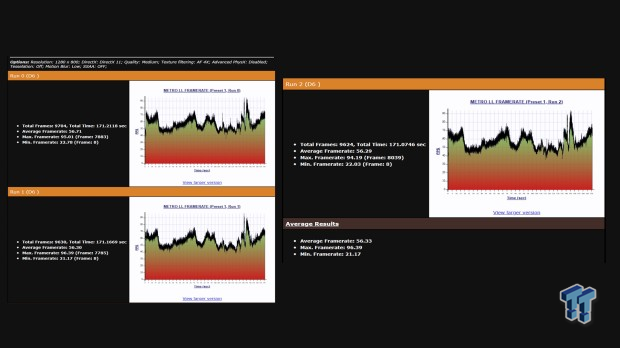
Pass 2 - 1280 x 800
- TDP Mode - Quiet
- OS Mode - Efficiency
Frames dropped quite a bit here, but FPS was variable depending on the pass. FPS ranged from 15-38FS on one pass, and 16-23 on another.
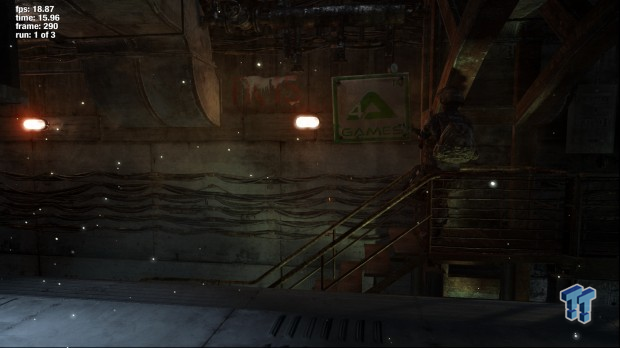
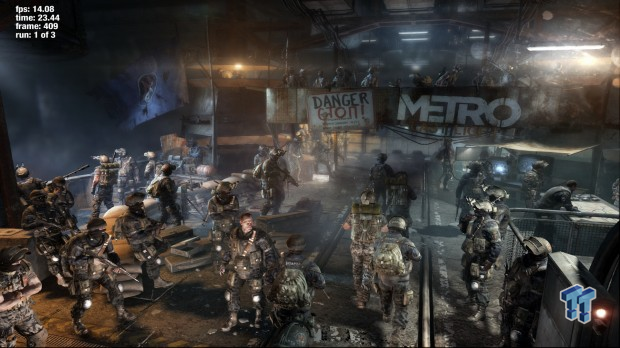
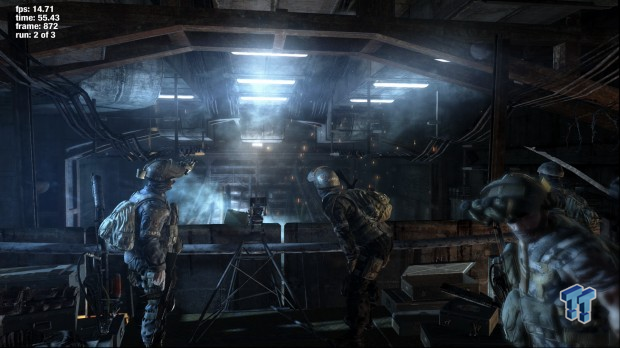
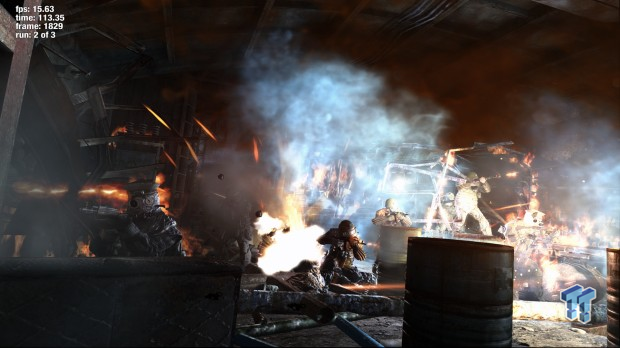
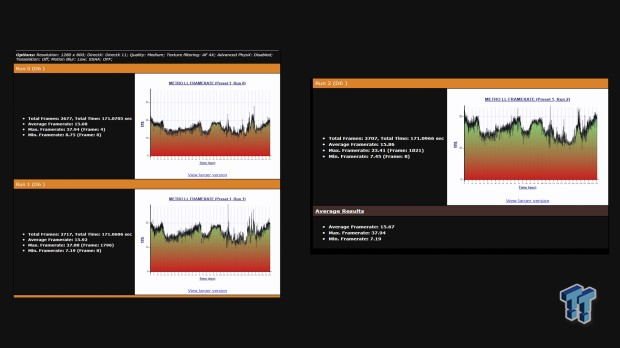
Pass 3 - 1920 x 1200
- TDP Mode - Balanced
- OS Mode - Balanced
Metro played a lot better with this config, and FPS was around on average 37 FPS, with minimum FPS dropping to 18FPS and max hitting 67. Visuals also looked solid.
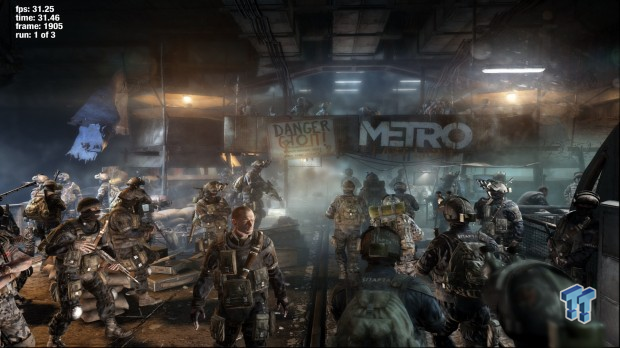
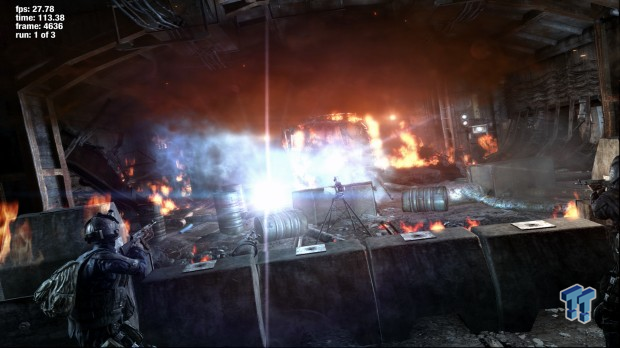
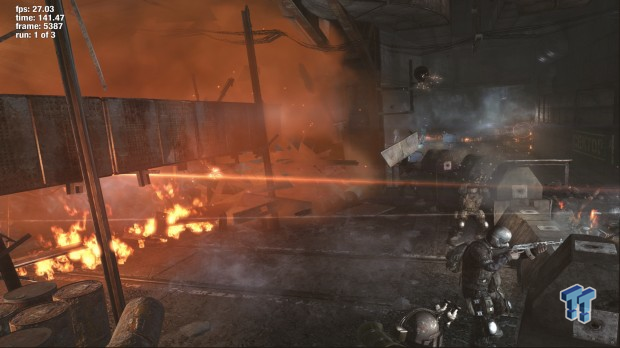
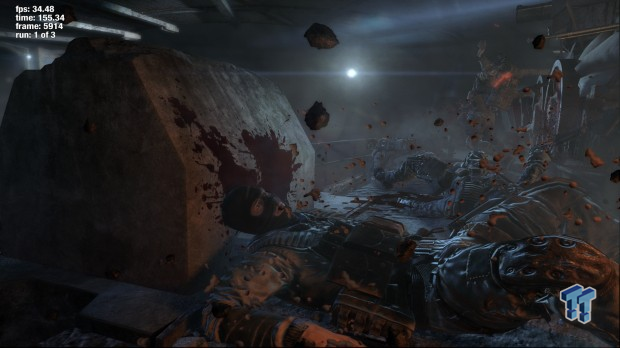
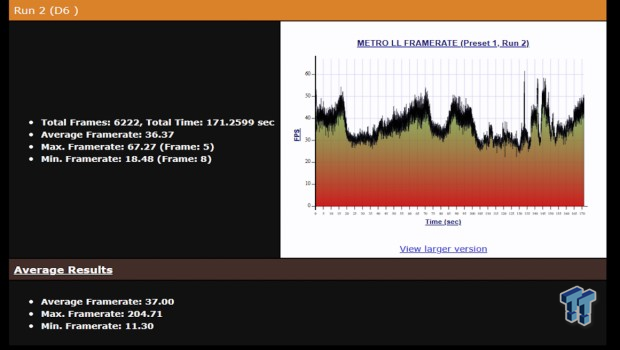
Pass 4 - 1920 x 1200
- TDP Mode - Performance
- OS Mode - Performance
More fantastic results thanks to the Performance preset; frames ranged from 18 minimum, 56 average, and 89 max FPS.
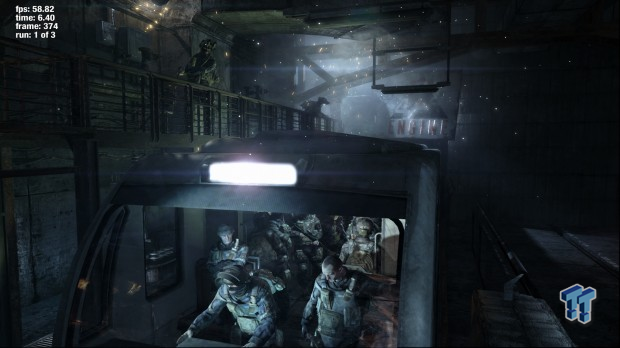
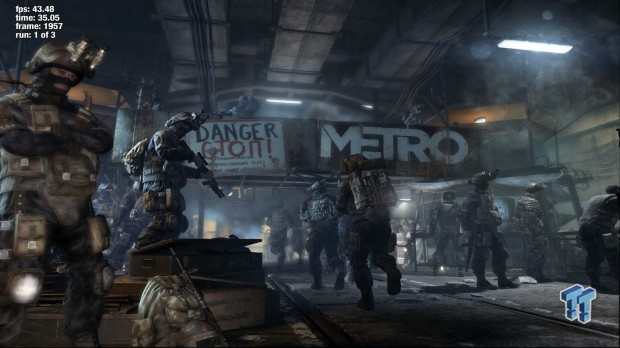
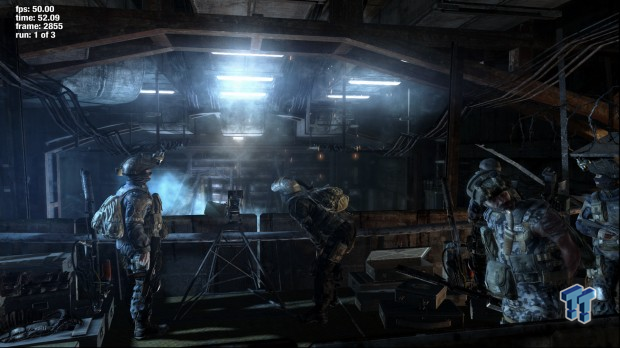
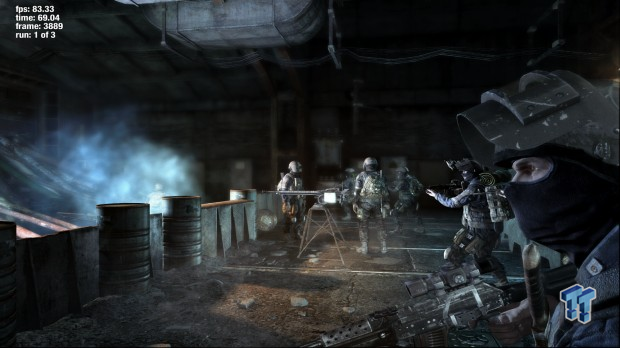
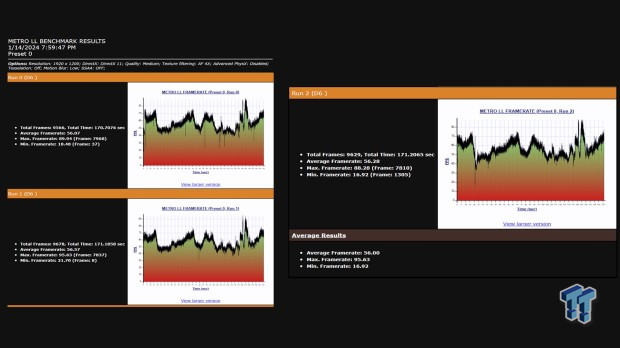
Pass 5 - 2560 x 1600
- TDP Mode - Performance
- OS Mode - Performance
Pass 5 delivered almost the exact same FPS performance as Pass 4, which is impressive considering the resolution jump.
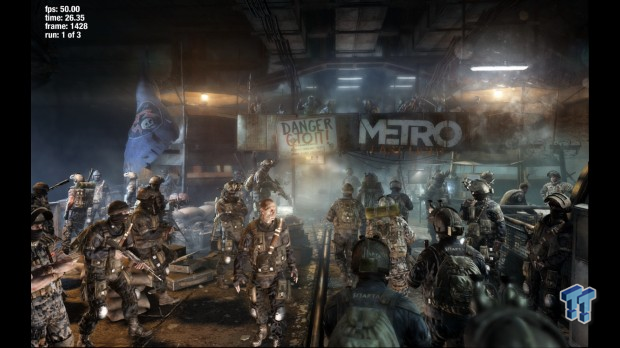
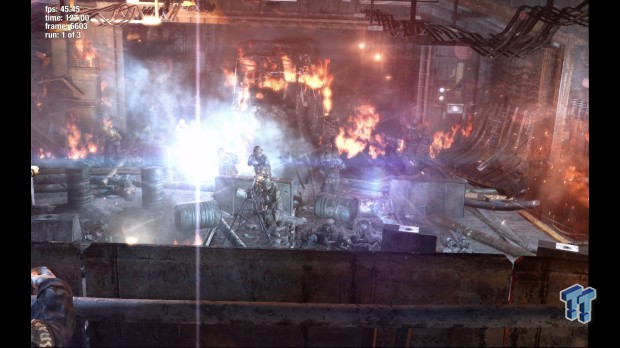
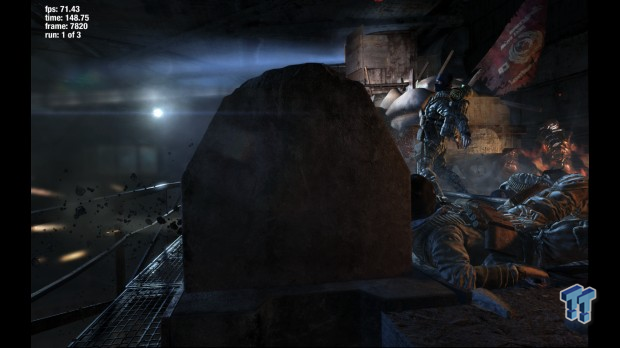
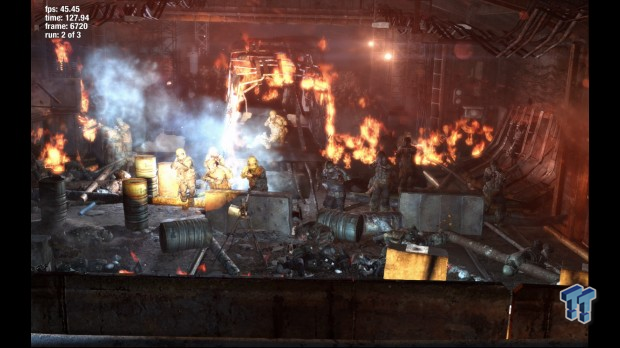
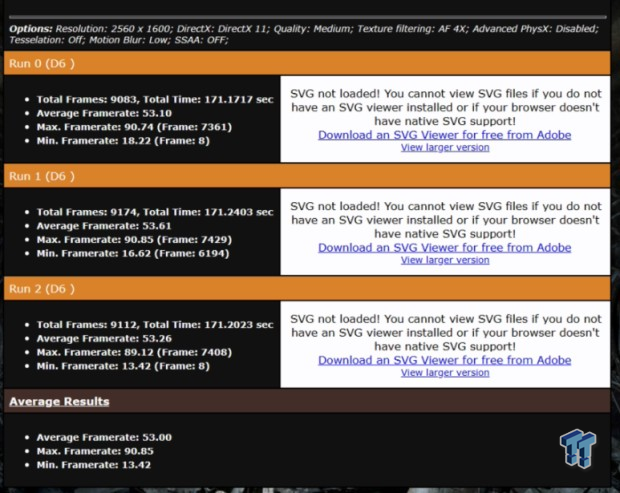
Pass 6 - 2560 x 1600
- TDP Mode - Quiet
- OS Mode - Efficiency
Results were as expected--not great. Minimum FPS was at around 4-6 frames per second, the average was at 14FPS, and frames maxed out at around 30-36FPS.
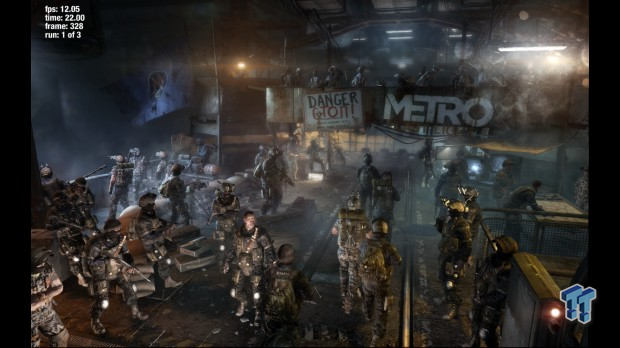
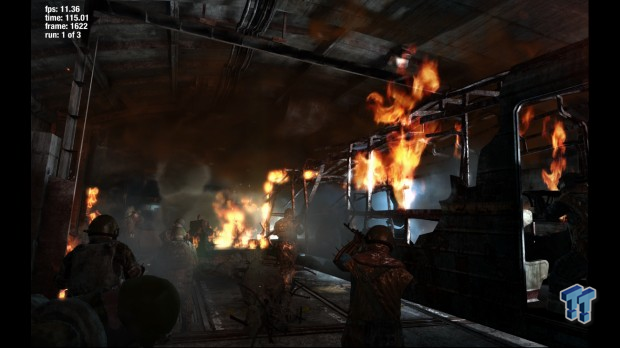
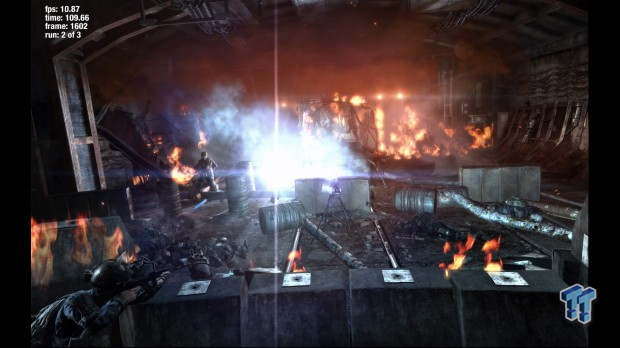
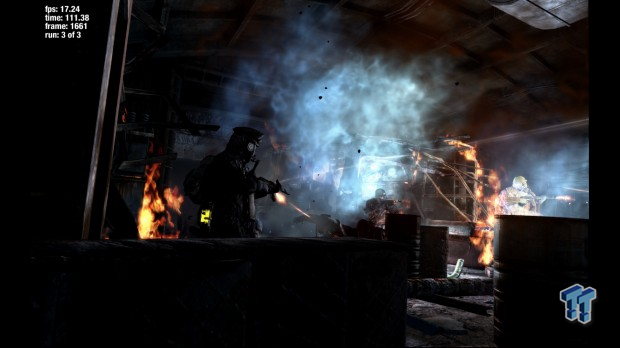
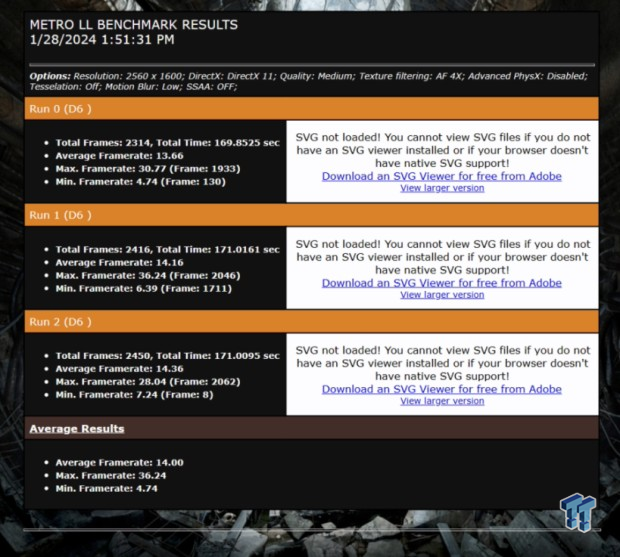
Plague Tale: Requiem
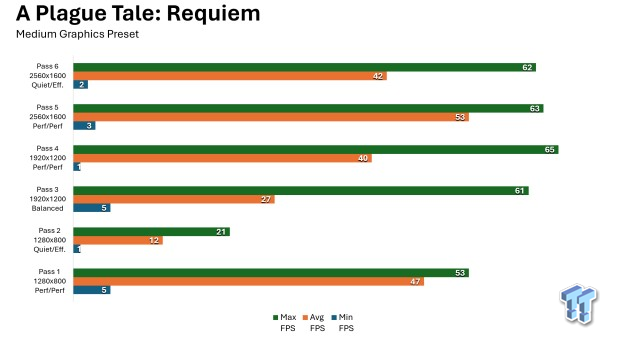
This is also a modern game, and it was chosen because it's pretty demanding. I was curious to see how well it would run on the Legion Go, and the results were surprising. Plague Tale delivered a steady 45-50FPS with Perf/Perf presets in varying resolutions.
That being said, the menus were some of the big reasons for the large FPS jumps in modes like the Quiet/Efficiency config. The FPS spikes do not necessarily reflect actual gameplay. This is also the case for the lowest of the low FPS drops--I didn't really experience the 1-5 low FPS ranges while playing the game.
Pass 1 - 1280 x 800
- TDP Mode - Performance
- OS Mode - Performance
Solid results with average FPS at a clean 47 frames per second. Graphics also looked pretty good for a handheld. No real noticeable FPS drops or stutters.
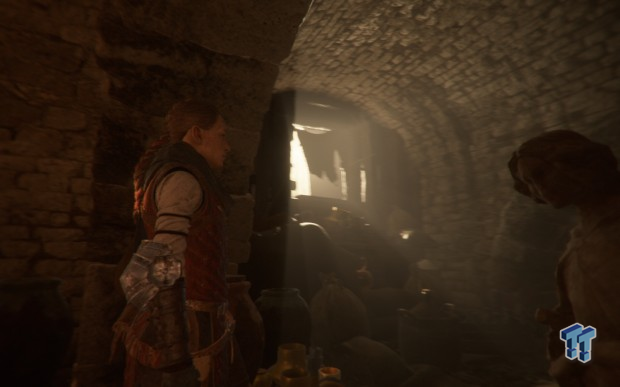
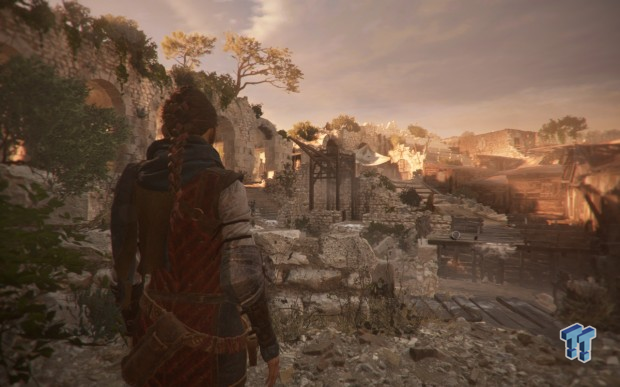
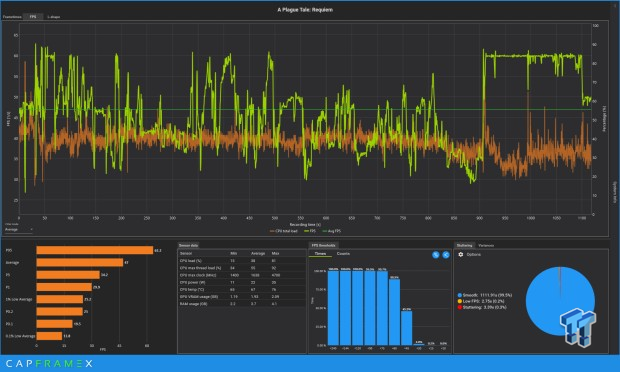
Pass 2 - 1280 x 800
- TDP Mode - Quiet
- OS Mode - Efficiency
FPS was significantly hit, and there were multiple bad frame stutters throughout play, but the handheld stayed cool and quiet. The average FPS stood at around 12 frames per second.
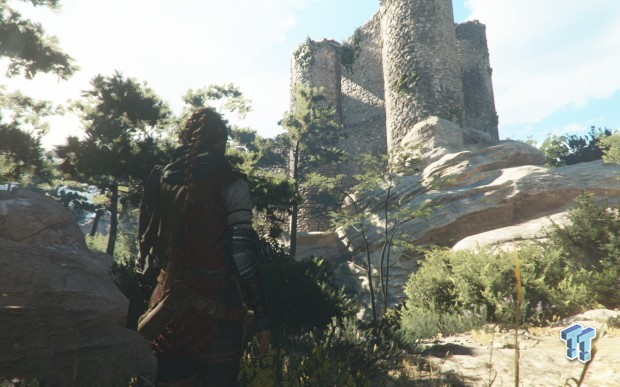
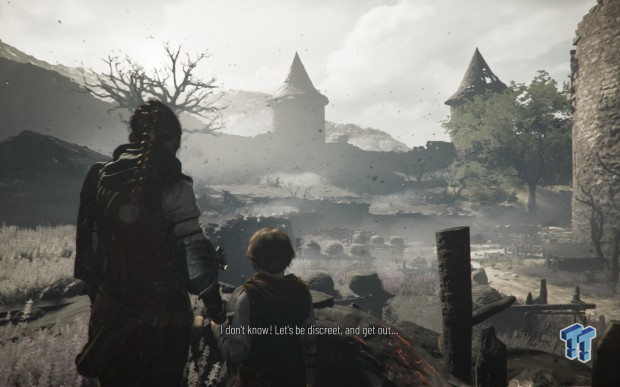
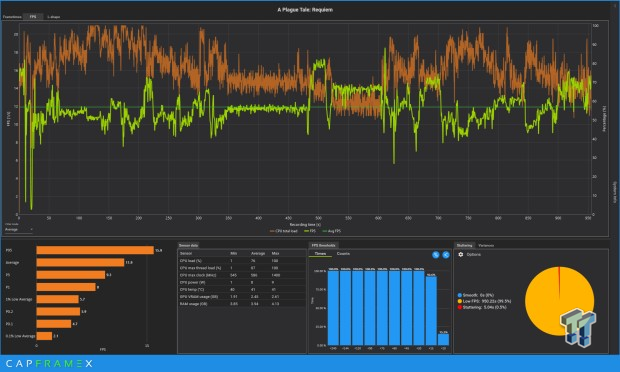
Pass 3 - 1920 x 1200
- TDP Mode - Balanced
- OS Mode - Balanced
Gameplay felt decent, no input issues or noticeable FPS drops. Average frames were around 27FPS.
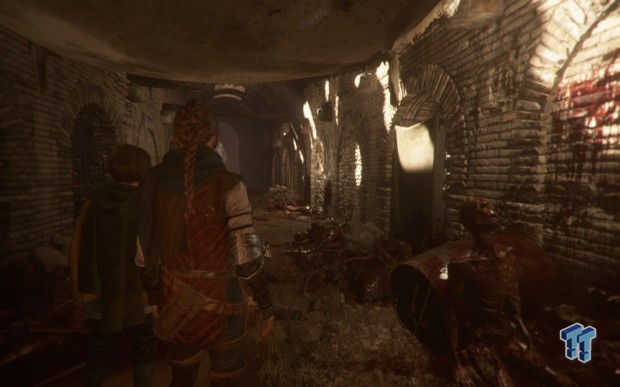
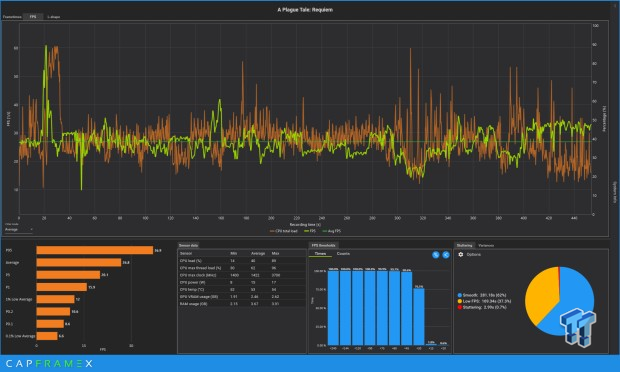
Pass 4 - 1920 x 1200
- TDP Mode - Performance
- OS Mode - Performance
Average FPS was around 40 frames per second, and graphics were pretty stellar for such a small screen.
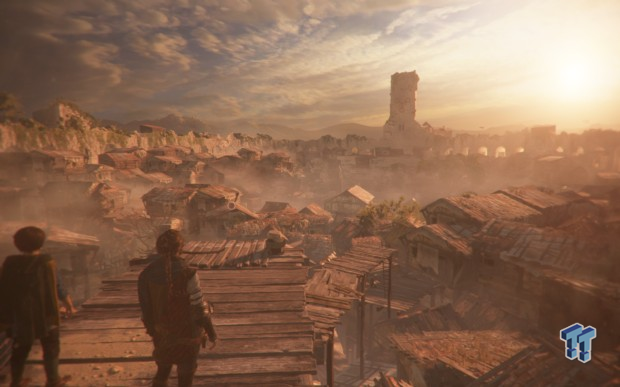
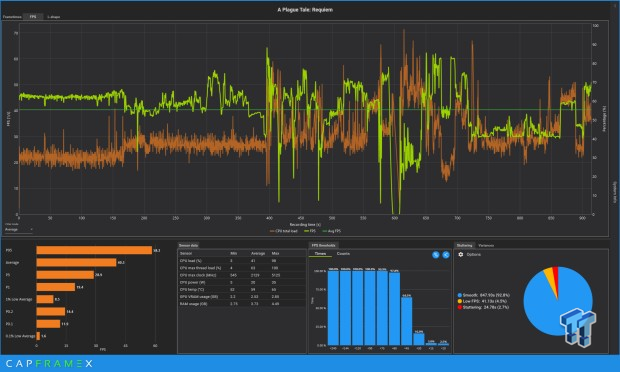
Pass 5 - 2560 x 1600
- TDP Mode - Performance
- OS Mode - Performance
Being able to hit over 50FPS average at 2560 x 1600 is impressive to say the least. Everything looked great and felt smooth to play.
Fans kicked up quite a bit, which is to be expected playing on Performance mode at 2560x1200 resolution. I did see pop-in and NPCs started off in T-poses a few times before clicking into place and starting to move as they should. Graphis look great and didn't see any noticeable FPS drops.
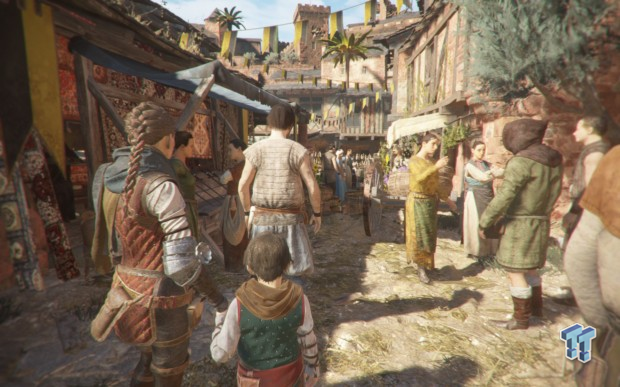
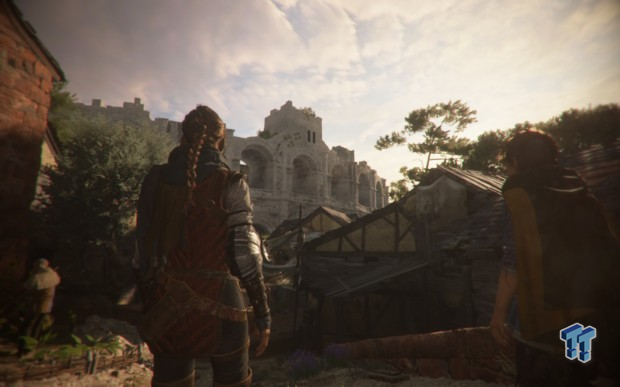
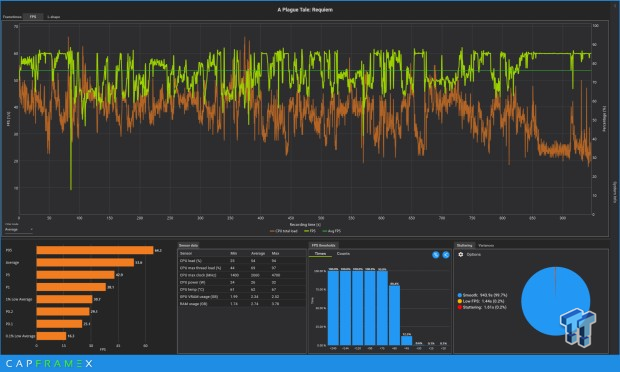
Pass 6 - 2560 x 1600
- TDP Mode - Quiet
- OS Mode - Efficiency
Plague Tale was one of the only games that played nicely with this config. Average FPS was at around 43 frames per second and the visuals kept their charming look.
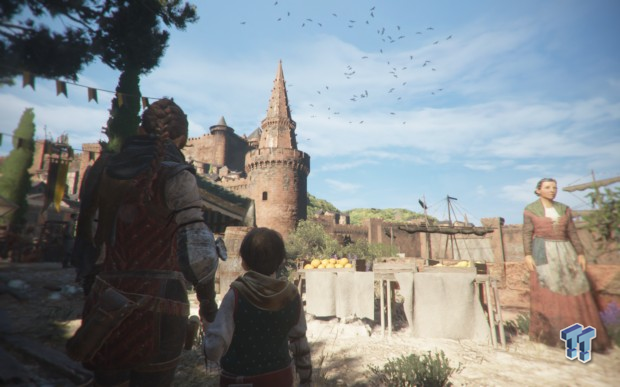
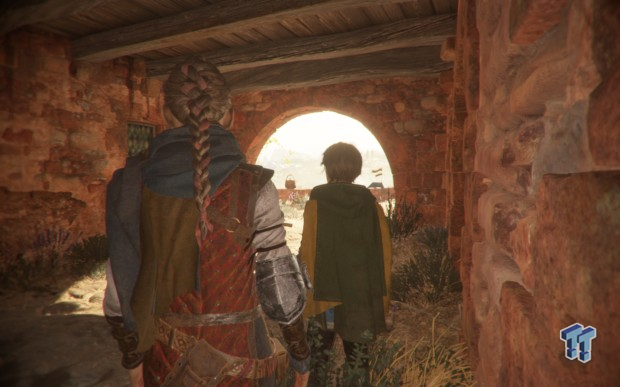
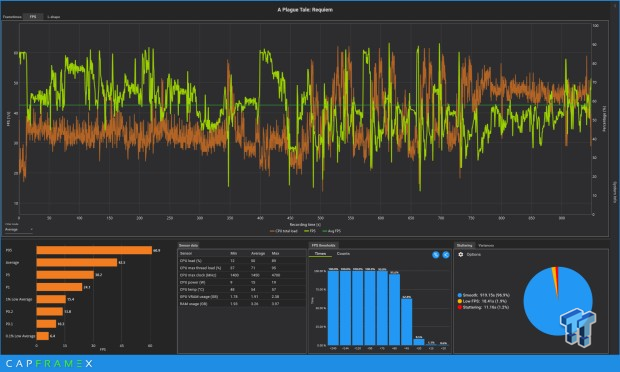
Shadow of the Tomb Raider
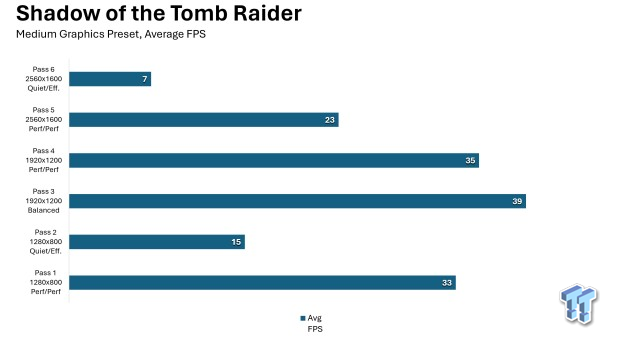
Shadow of the Tomb Raider is a decently demanding game with a built-in benchmark, so we used that tool out of convenience. All tests were conducted on native resolution, but we chose to vary between Medium and High graphics preset settings just out of curiosity.
Pass 1 - 1280 x 800
- TDP Mode - Performance
- OS Mode - Performance
This was conducted in the High graphics preset, and the Legion Go did pretty well, hitting 23FPS minimum and 36FPS average at 1280x800.
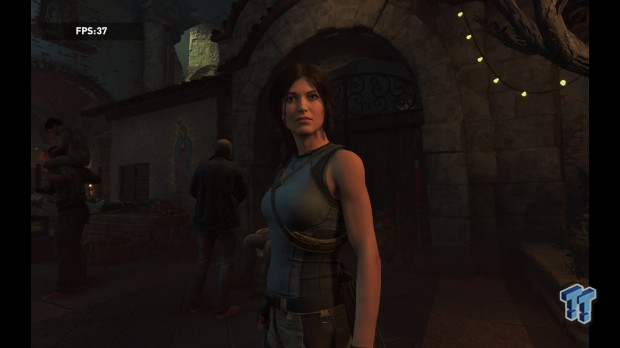
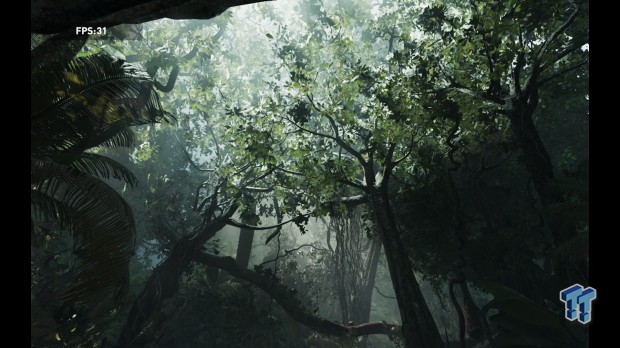
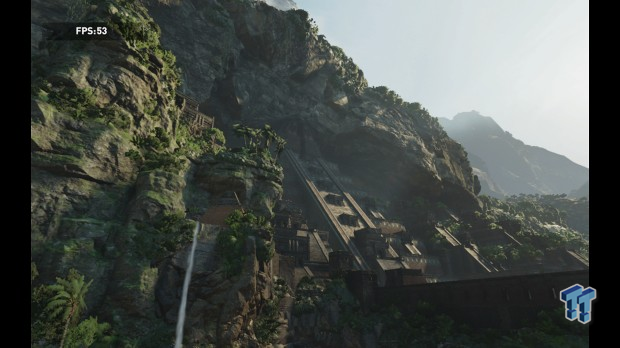
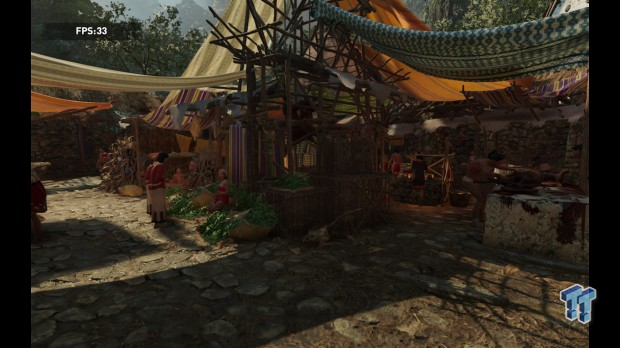
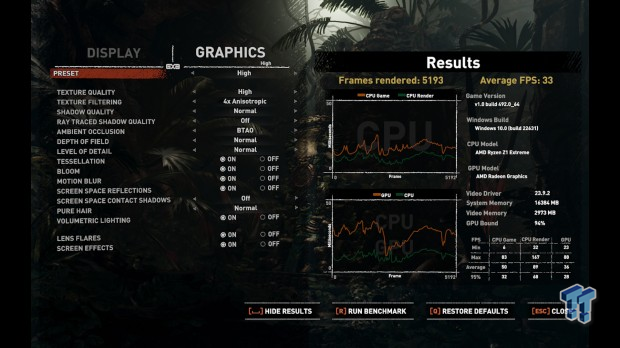
Pass 2 - 1280 x 800
- TDP Mode - Quiet
- OS Mode - Efficiency
Once again, FPS took a major dive with this config. At Medium graphics preset, Shadow of the Tomb Raider ran at an average FPS of just 15 frames per second.
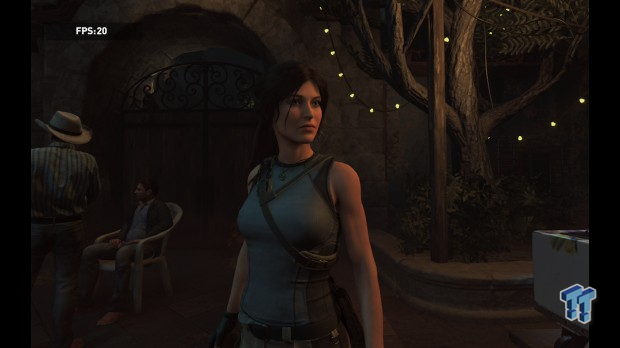
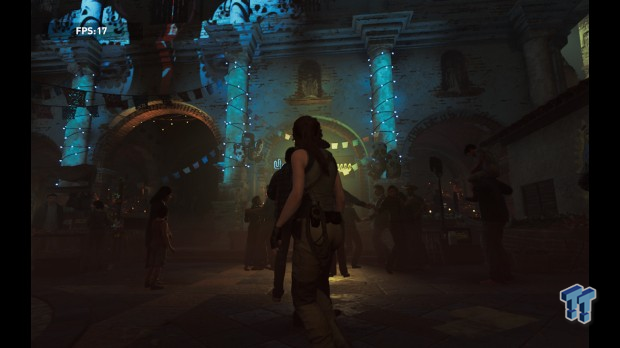
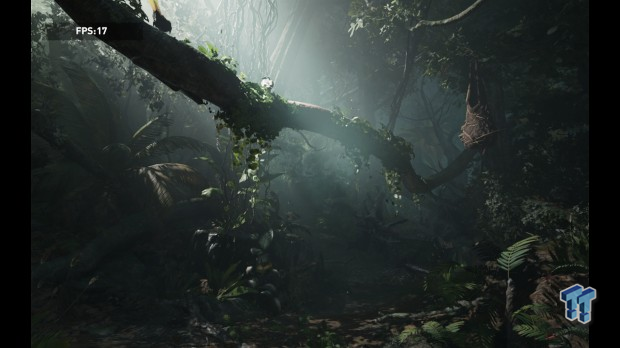
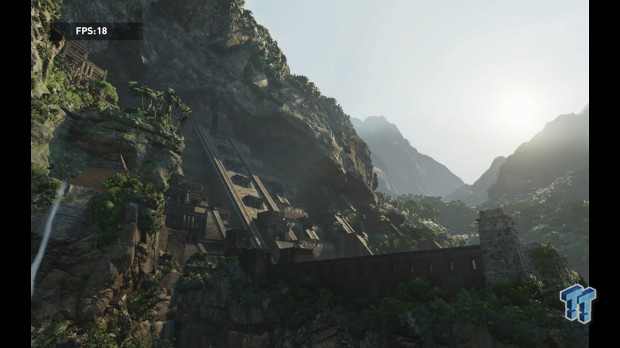
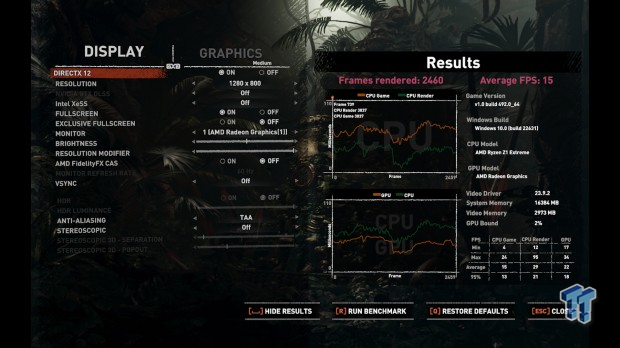
Pass 3 - 1920 x 1200
- TDP Mode - Balanced
- OS Mode - Balanced
At Medium preset, this config was able to achieve an average 39FPS in the bench tool. That's pretty decent for gameplay on a handheld like this.
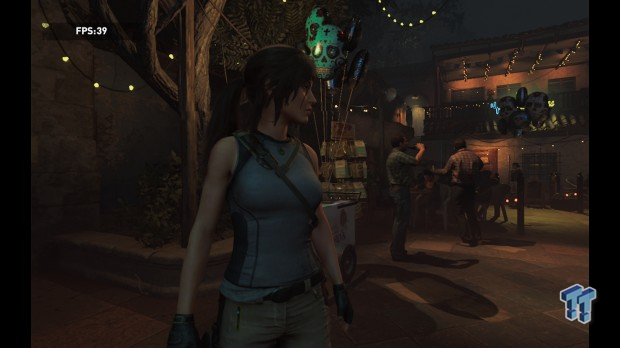
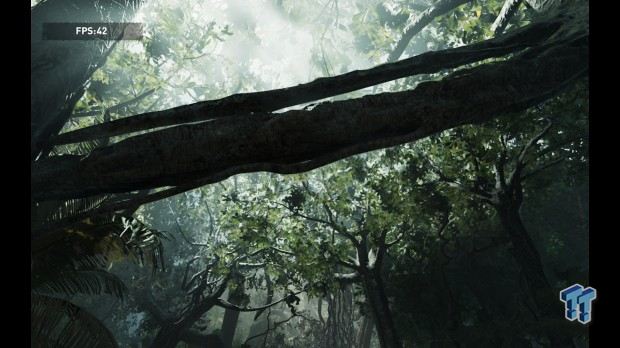
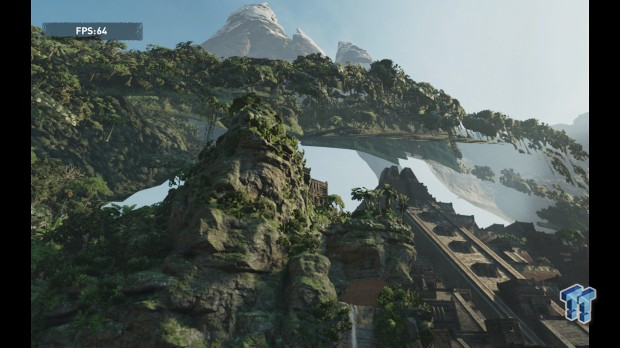
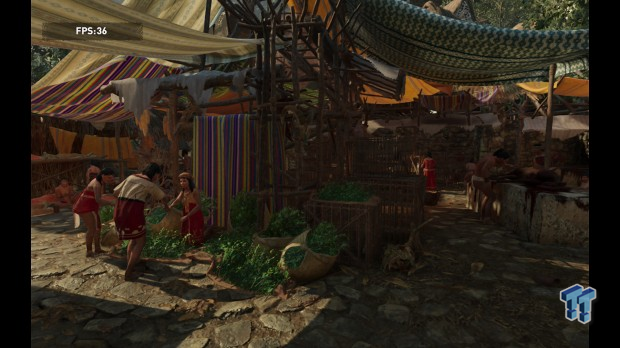
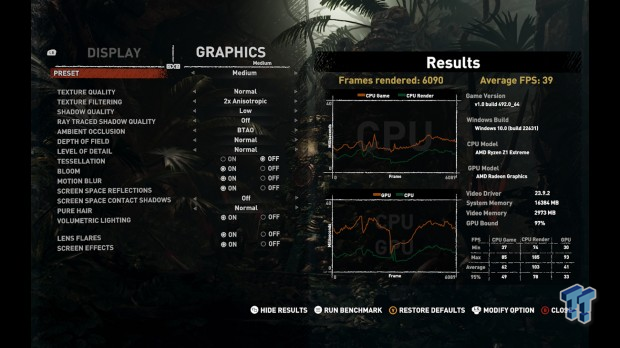
Pass 4 - 1920 x 1200
- TDP Mode - Performance
- OS Mode - Performance
Good FPS here as well, with an average frame rate of 35 with Medium preset. Definitely playable with good results.
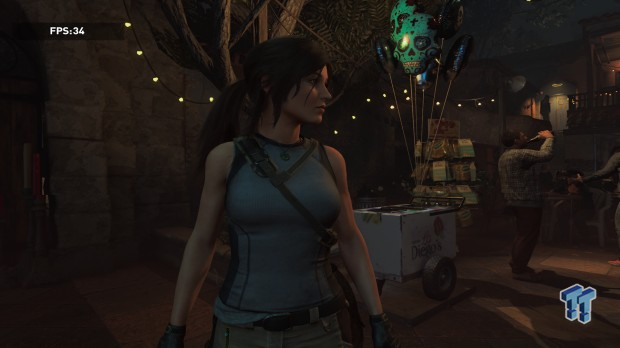
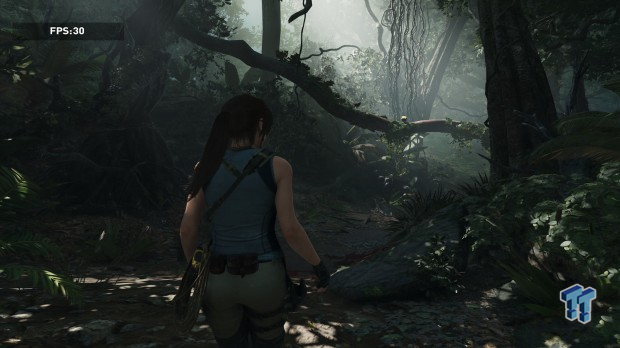
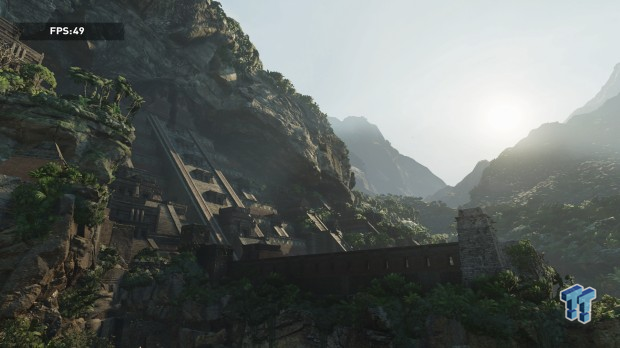
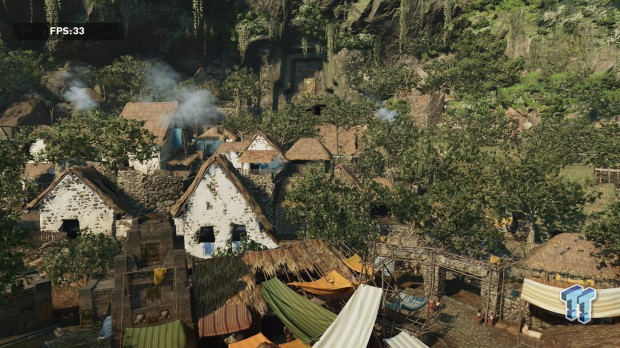
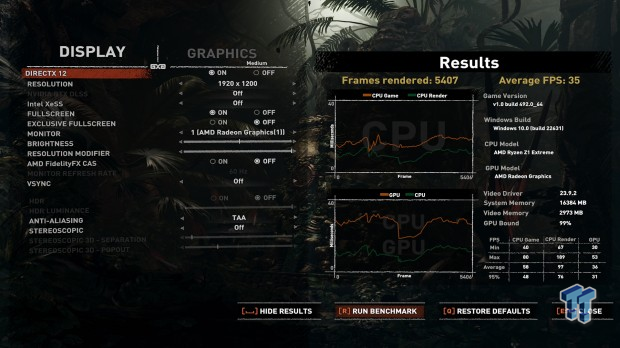
Pass 5 - 2560 x 1600
- TDP Mode - Performance
- OS Mode - Performance
The resolution bump took its toll, so it's not advised that you play Shadow of the Tomb Raider at 2560p on the Legion Go. Average FPS dropped to just 23 FPS.
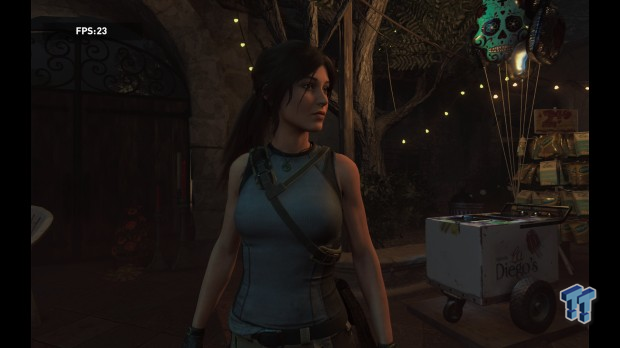
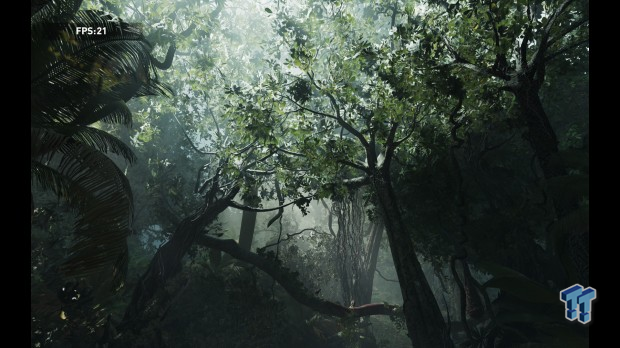
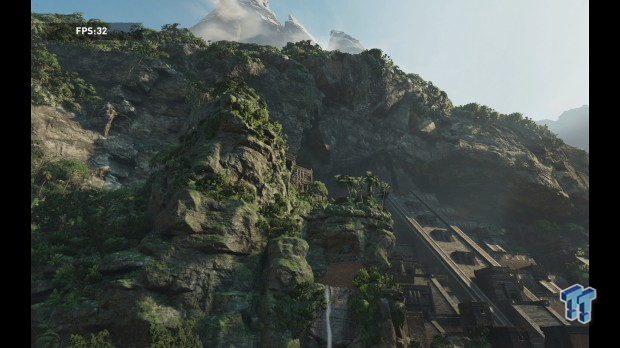
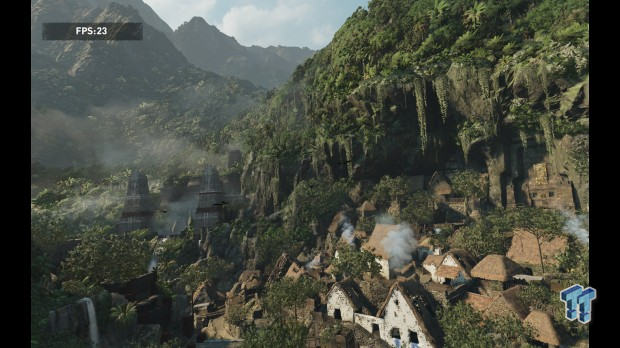
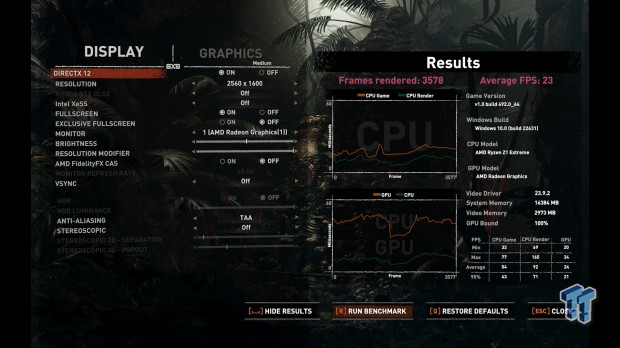
Pass 6 - 2560 x 1600
- TDP Mode - Quiet
- OS Mode - Efficiency
The game was virtually unplayable in this config, with FPS dropping to an average of just 7 frames per second.
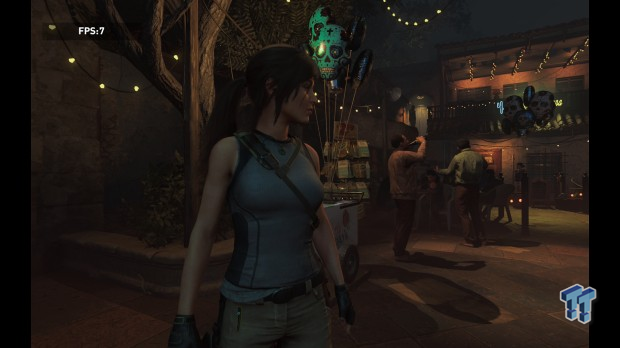
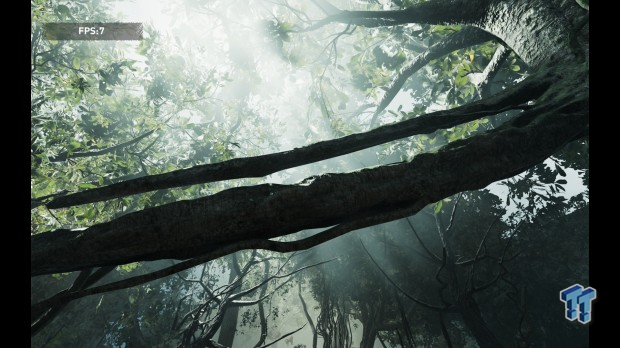
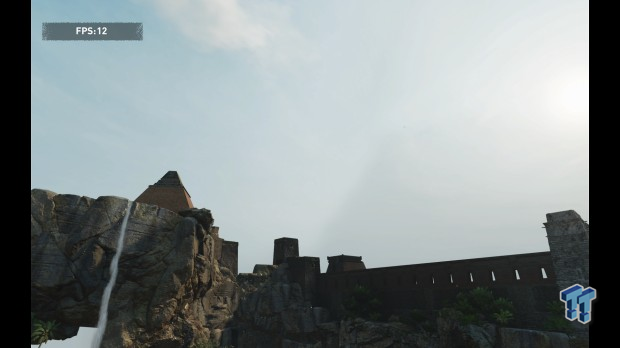
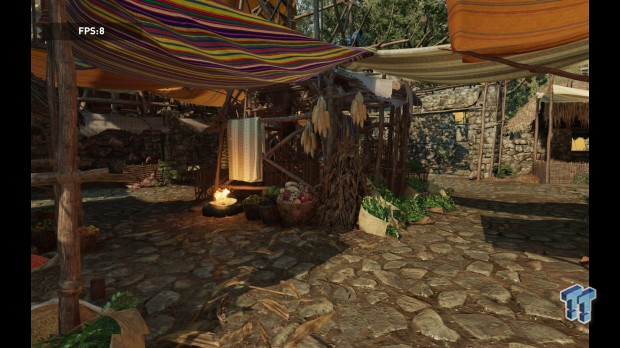
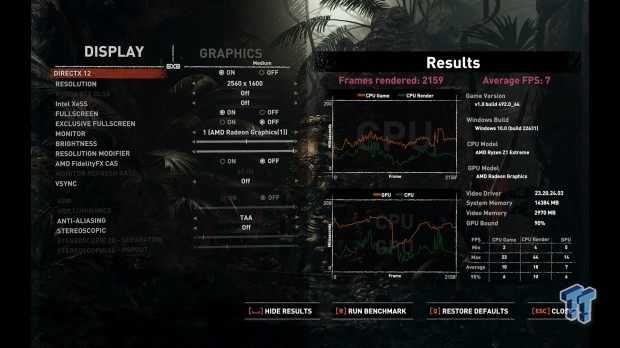
Shadow of War
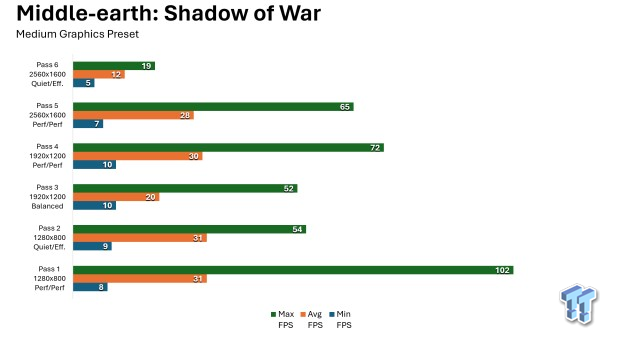
This is an older game and not so demanding by today's standards, but it also featured a built-in benching tool.
All passes were run at native resolution at Medium graphics preset.
Pass 1 - 1280 x 800
- TDP Mode - Performance
- OS Mode - Performance
So-so results here at 31FPS average. Dropping settings down to Low is mostly advised for this game.
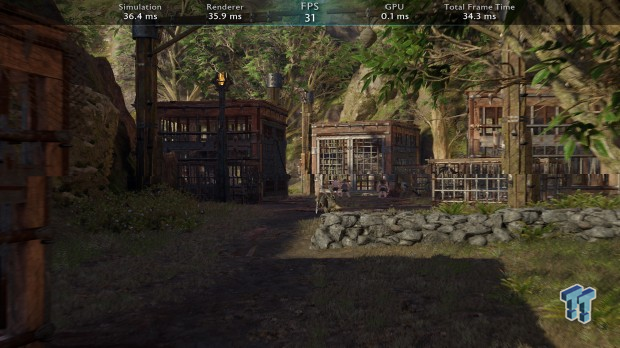
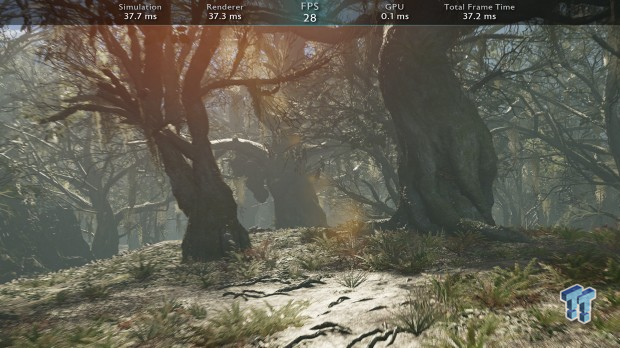
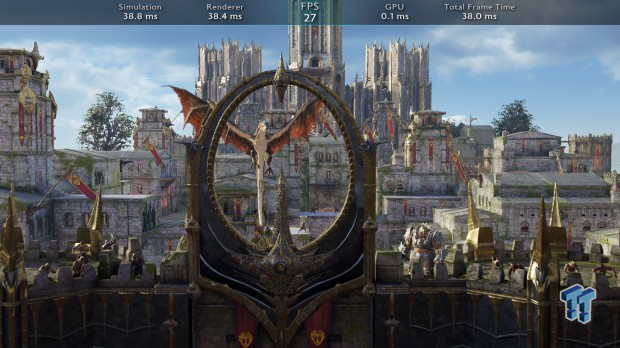
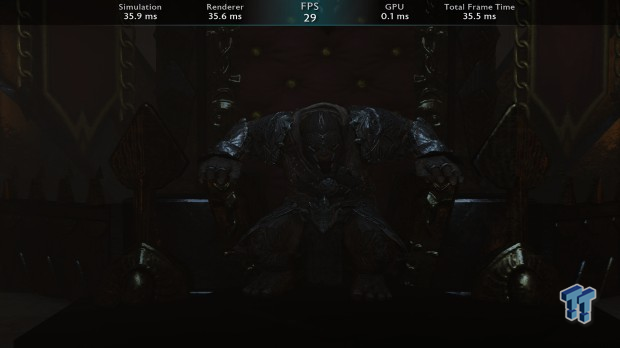
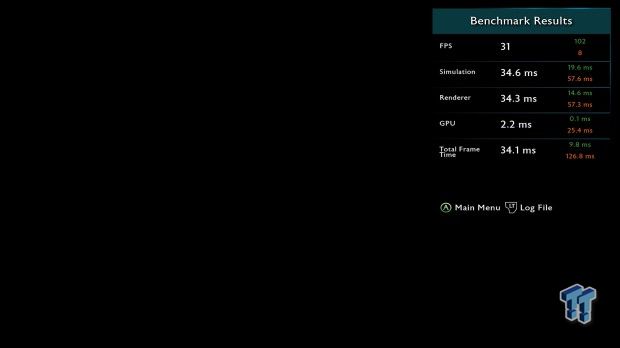
Pass 2 - 1280 x 800
- TDP Mode - Quiet
- OS Mode - Efficiency
These were surprising results. Somehow, Shadow of War maintained its 31FPS even with the dreaded Quiet x Efficiency config.
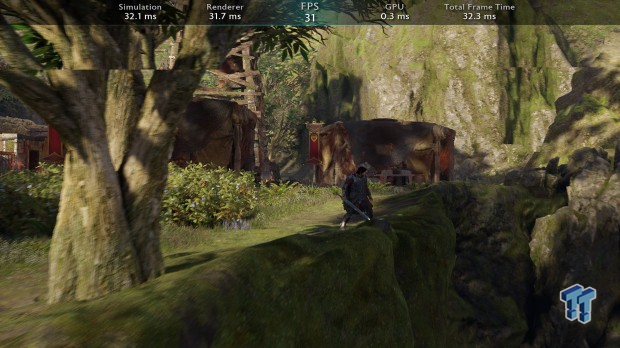
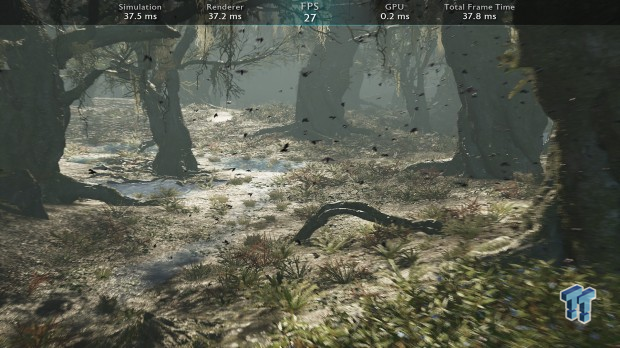
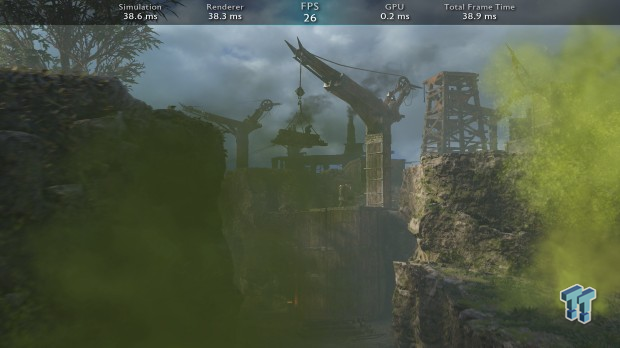
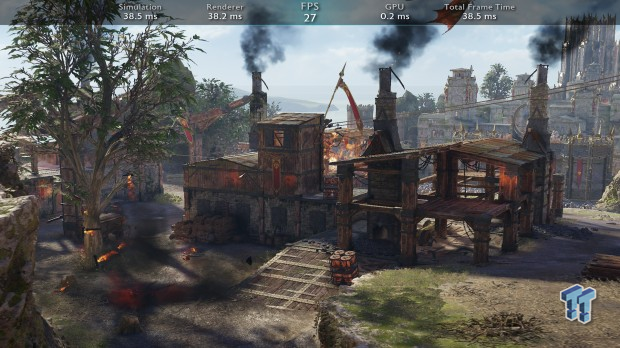
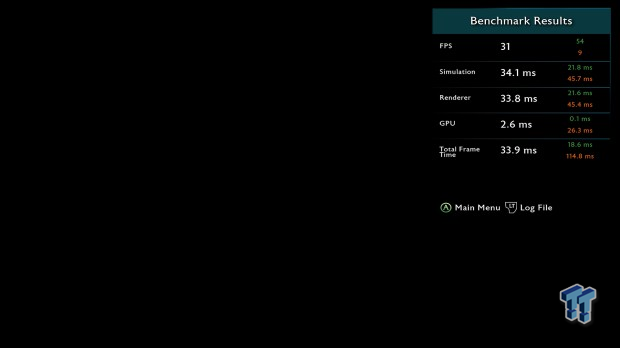
Pass 3 - 1920 x 1200
- TDP Mode - Balanced
- OS Mode - Balanced
FPS dropped a bit in balanced mode and the upped resolution, with average 20FPS.
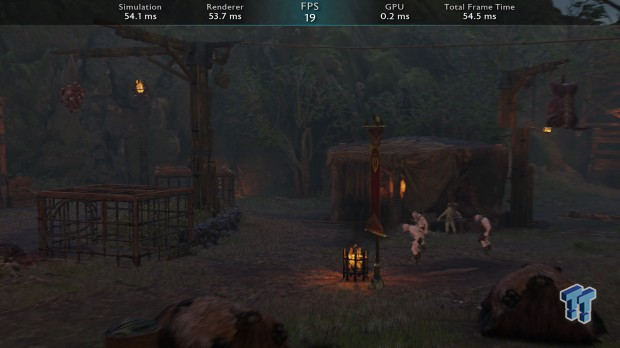
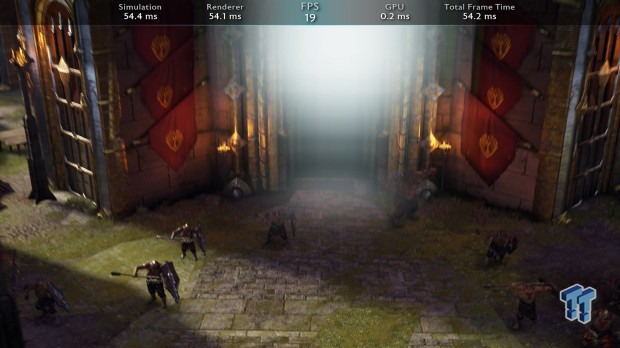
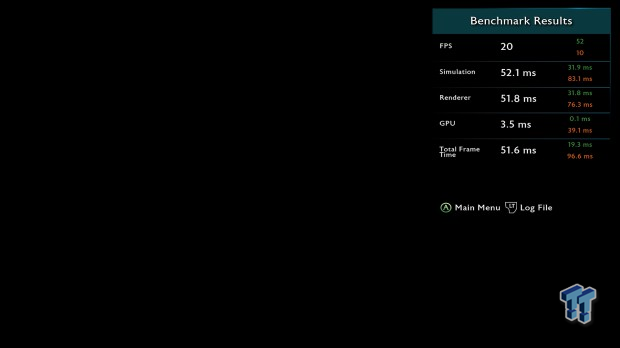
Pass 4 - 1920 x 1200
- TDP Mode - Performance
- OS Mode - Performance
Solid results as to be expected with 30FPS average at Medium preset.
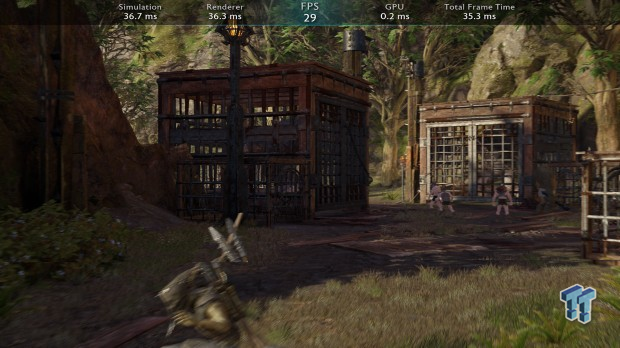
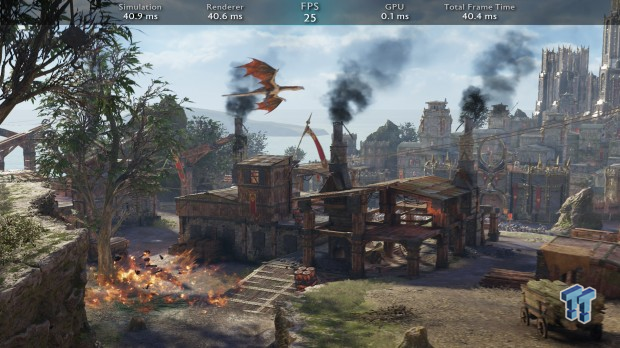
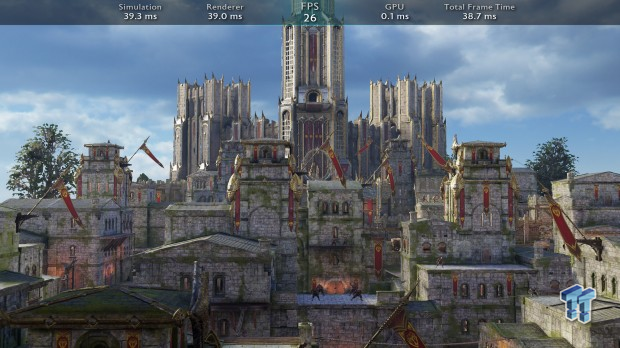
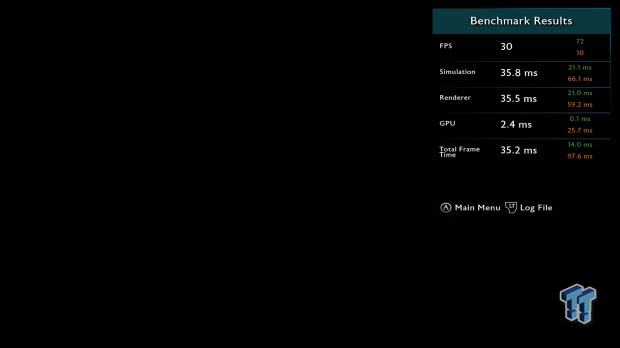
Pass 5 - 2560 x 1600
- TDP Mode - Performance
- OS Mode - Performance
A small hit to FPS here with 28 frames per second average, so adjusting the resolution and/or settings is required to go beyond 30FPS.
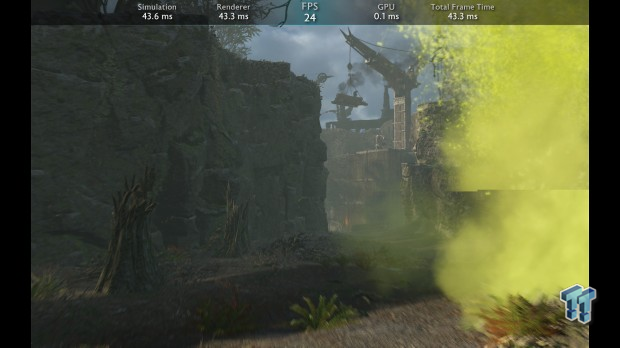
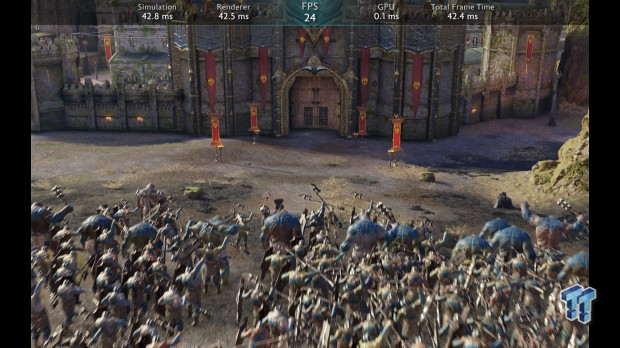
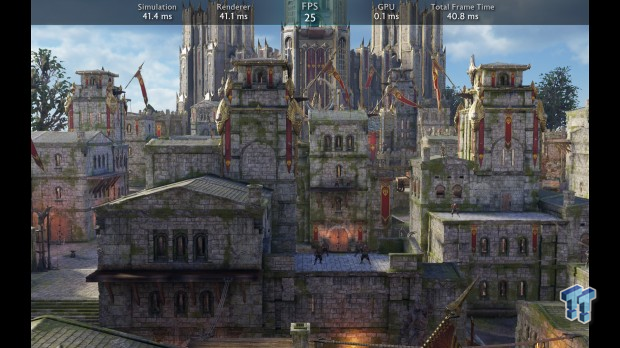
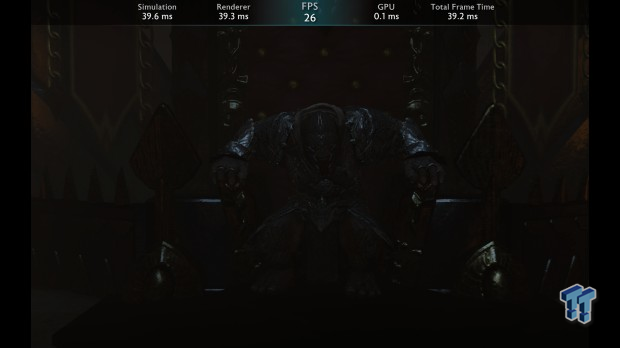
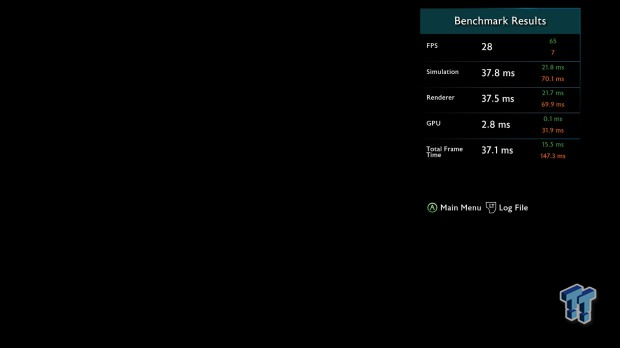
Pass 6 - 2560 x 1600
- TDP Mode - Quiet
- OS Mode - Efficiency
Once again, an unplayable FPS result for this config.
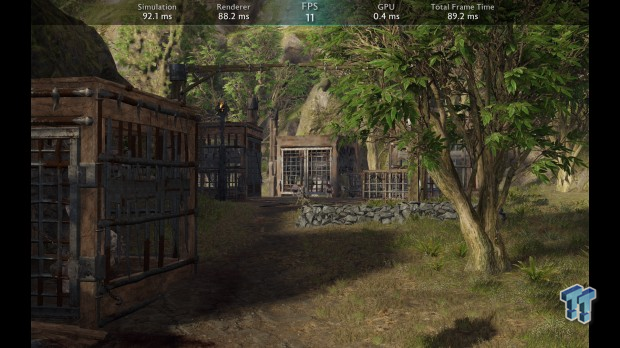
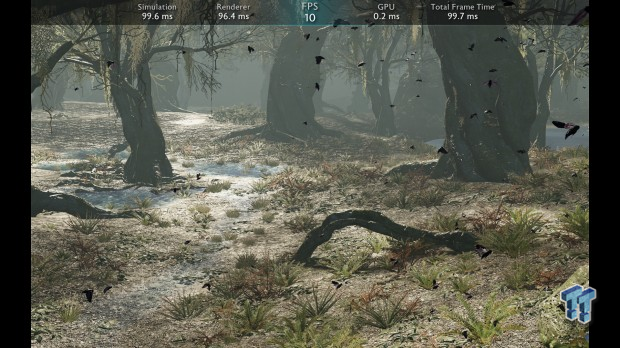
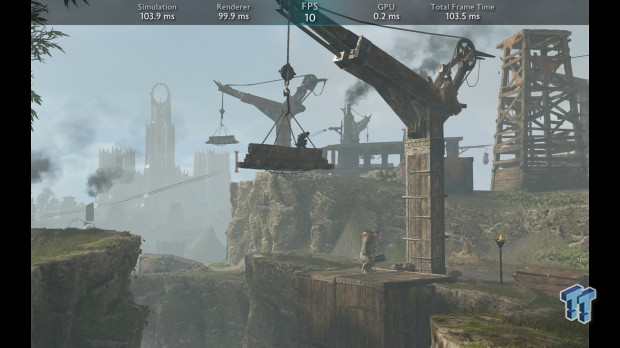
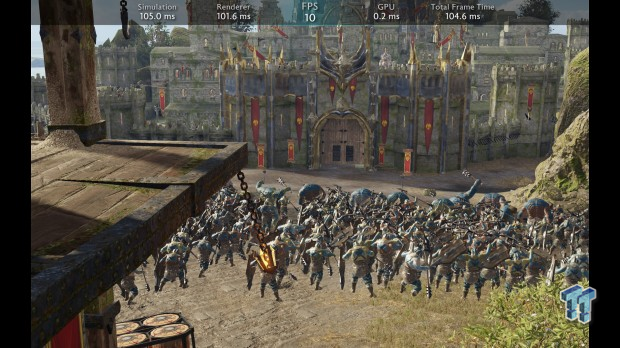
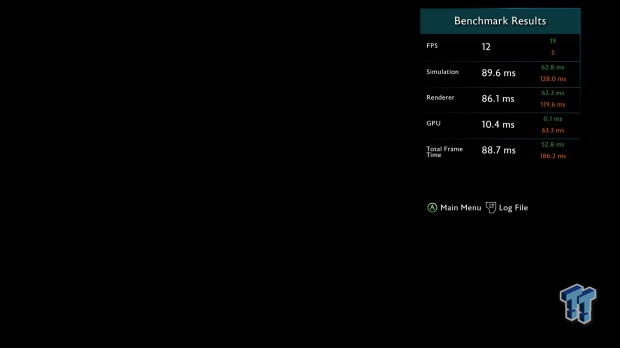
Starfield
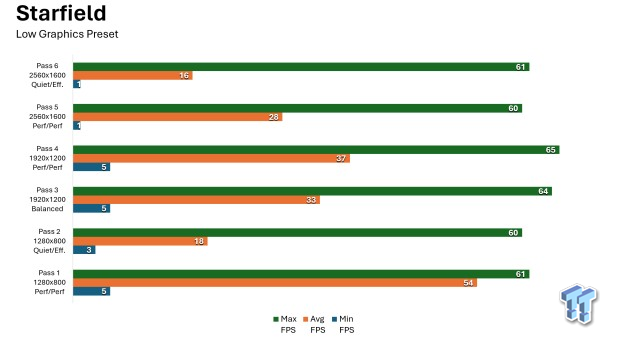
Bethesda's latest RPG makes use of new optimizations in an upgraded engine, and has had to be scaled to 30FPS on Xbox Series X/S consoles.
This test was conducted with the Low graphics preset using CapFrameX.
Pass 1 - 1280 x 800
- TDP Mode - Performance
- OS Mode - Performance
Graphics are not great, obvious pixellations and low-end visuals (which is to be expected at this resolution and preset). The trade off is that FPS was really high, hitting around 54 frames per second on average.
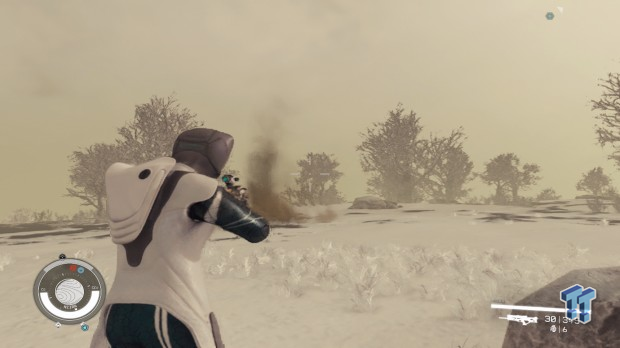
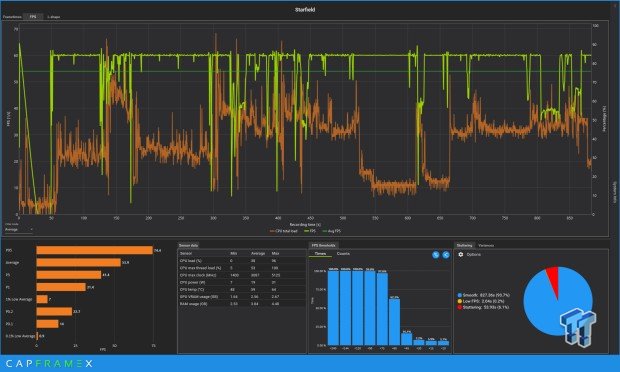
Pass 2 - 1280 x 800
- TDP Mode - Quiet
- OS Mode - Efficiency
FPS dropped heavily and low FPS accounted for nearly 77% of frames. Average FPS was at 18.
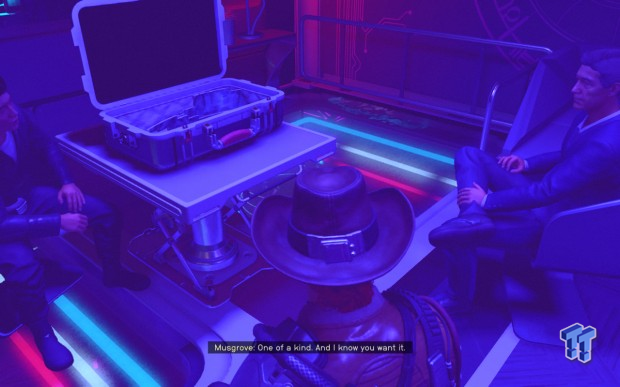
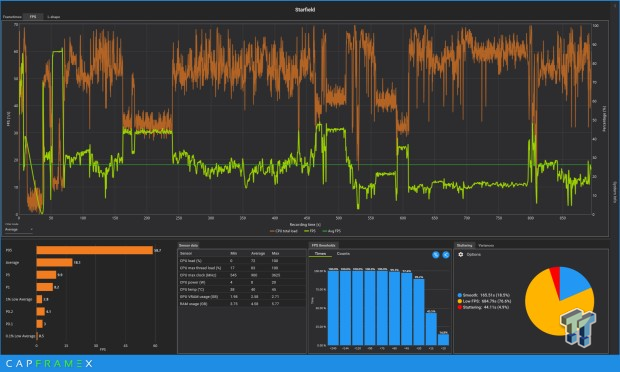
Pass 3 - 1920 x 1200
- TDP Mode - Balanced
- OS Mode - Balanced
Average FPS was in line with consoles, hitting 30 frames per second. Graphics and visuals were decent, but we're being bogged down by frequent FPS drops.
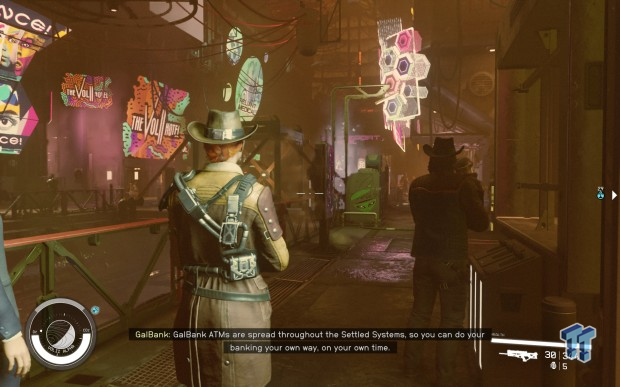
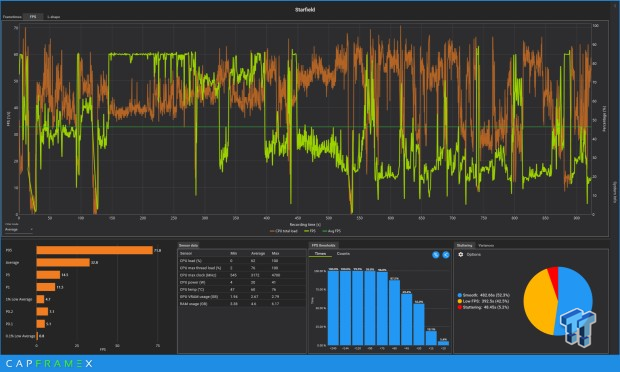
Pass 4 - 1920 x 1200
- TDP Mode - Performance
- OS Mode - Performance
Average FPS is a solid 37 and smooth frame rates overshadow the lower FPS occurrences, and graphics weren't impacted too much. Overall, this is a bit better than the kind of frame performance you'd find on consoles.
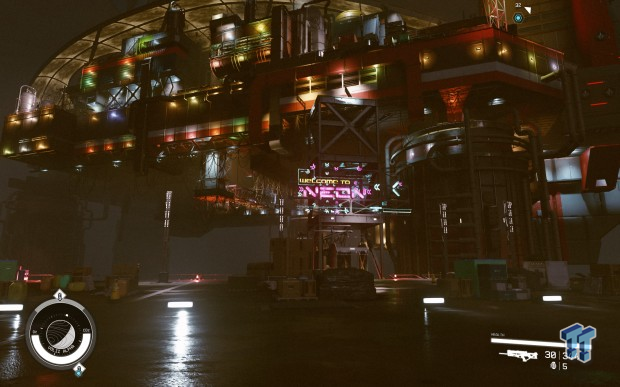
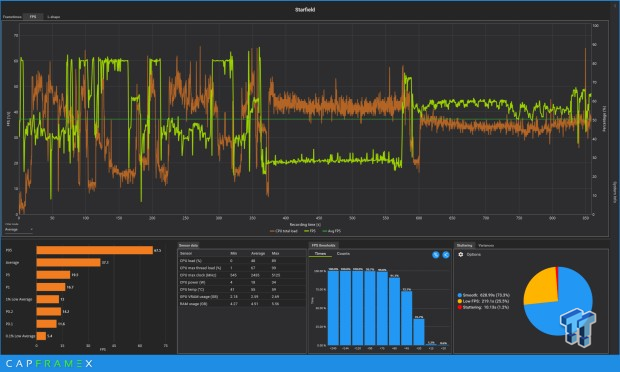
Pass 5 - 2560 x 1600
- TDP Mode - Performance
- OS Mode - Performance
The extra weight from the resolution boost pulls down FPS, but not by a whole lot. Starfield is still decently playable at a 27FPS-ish range, but there are more ideal performance vs resolution trade-offs to be made here.
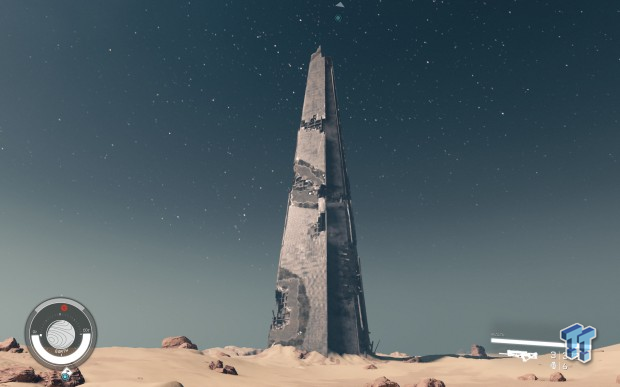
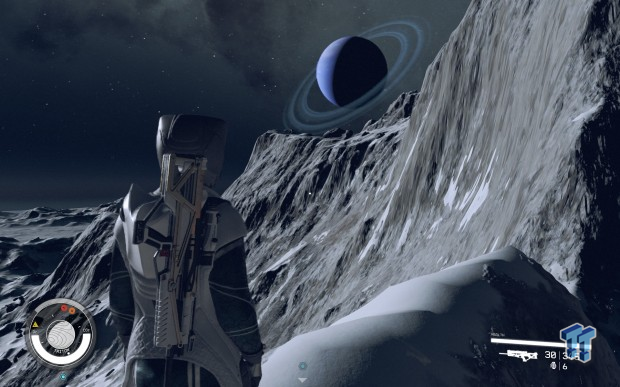
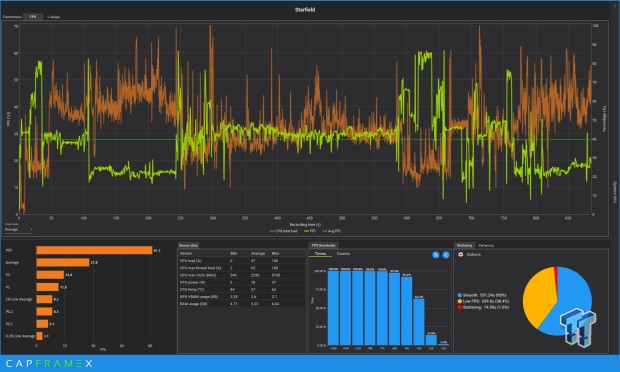
Pass 6 - 2560 x 1600
- TDP Mode - Quiet
- OS Mode - Efficiency
Not great performance here and this mode should be avoided, but it's still interesting to see the variances between games.
Starfield ran at 16FPS average in this config.
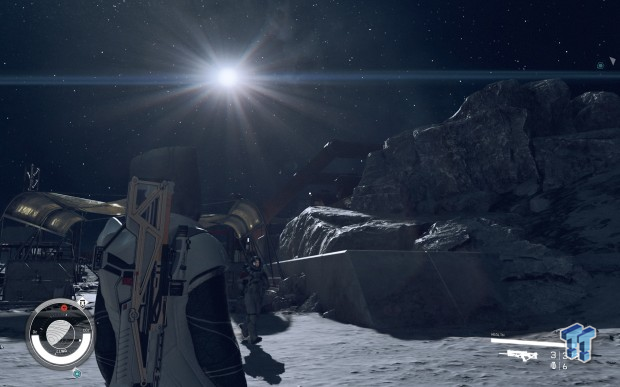
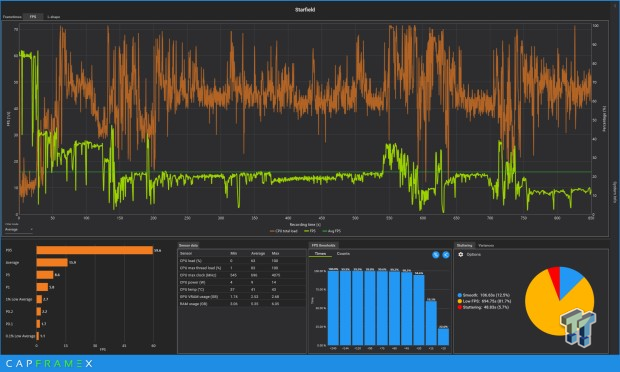
Performance Tests - 3D Mark
Fire Strike
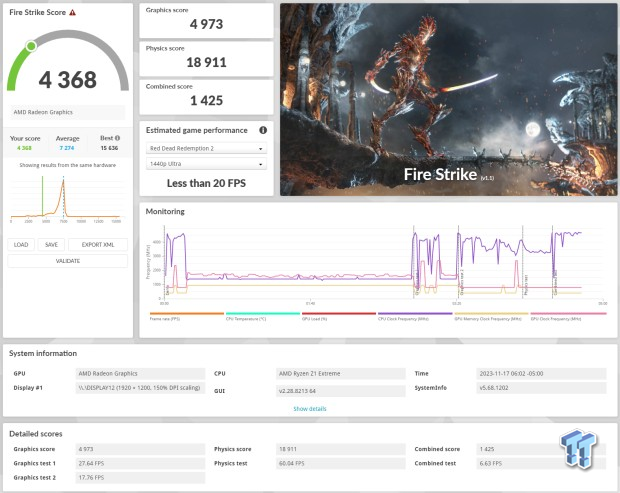
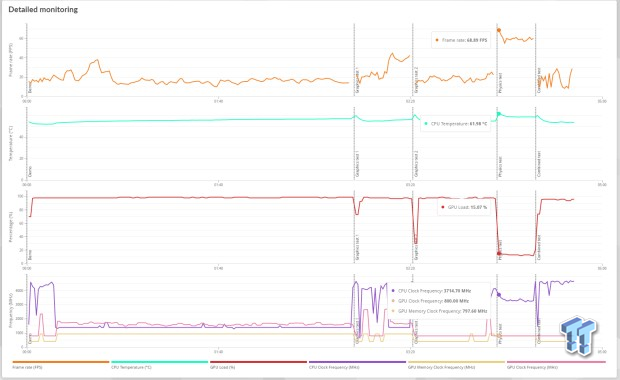
Fire Strike Extreme
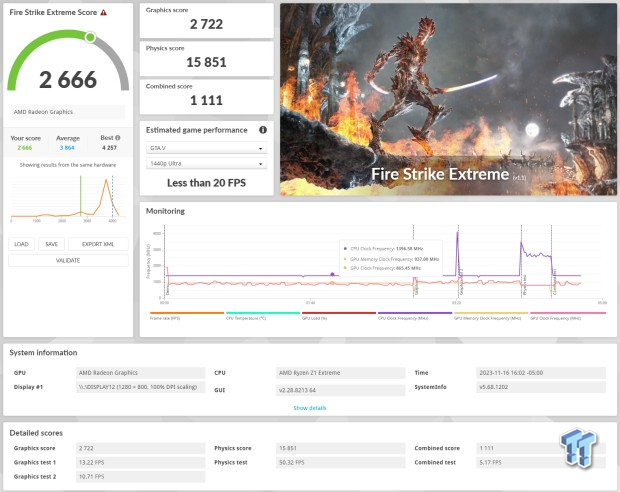
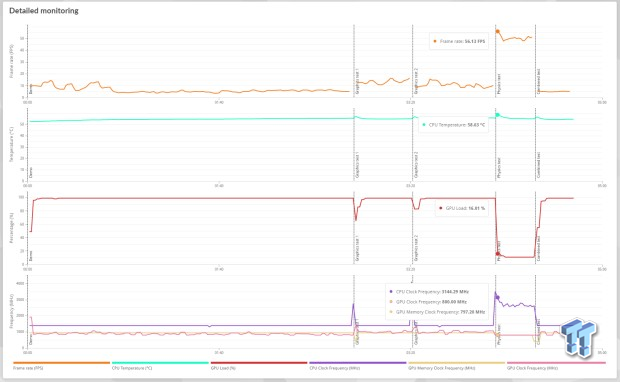
Night Raid
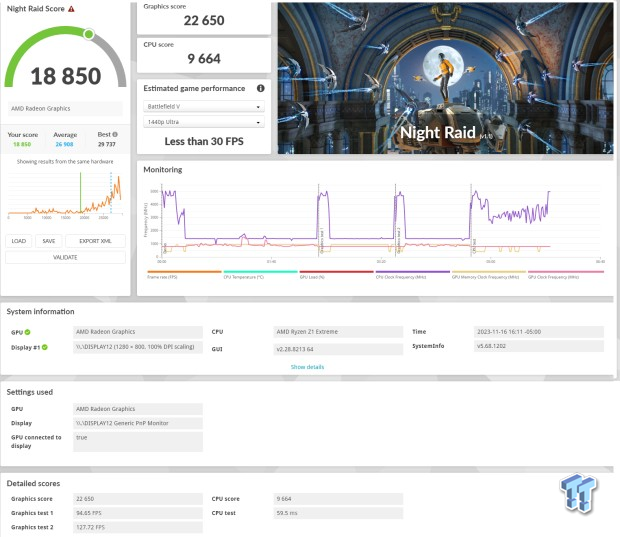
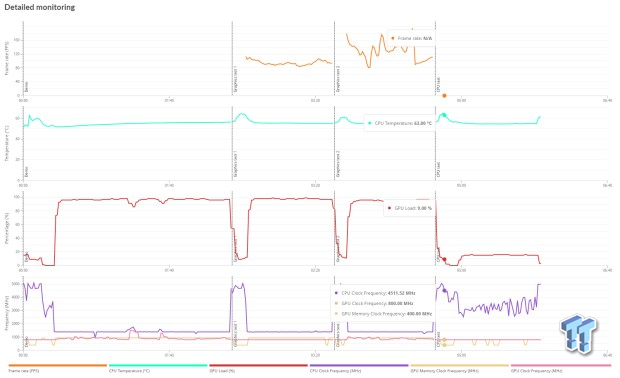
Port Royal
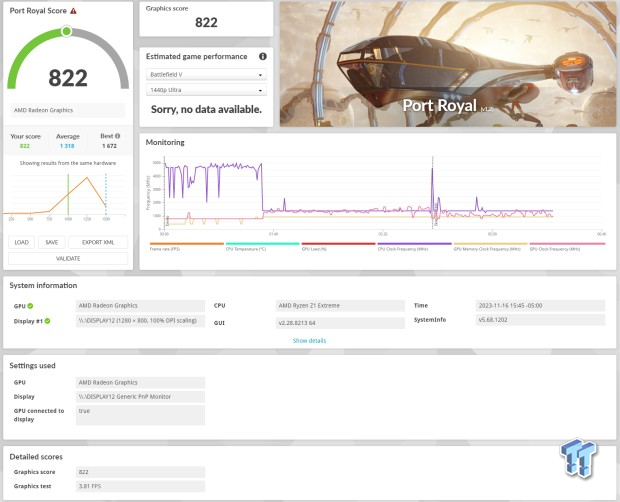
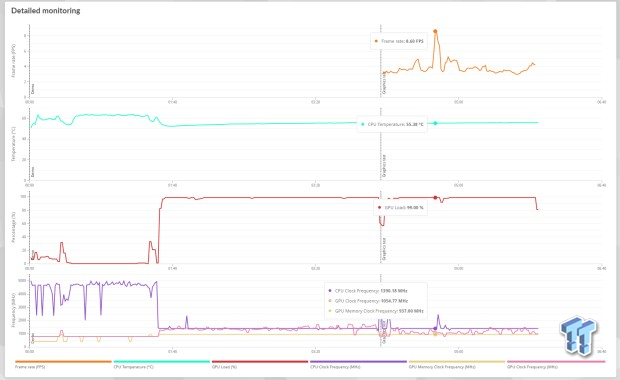
Speed Way
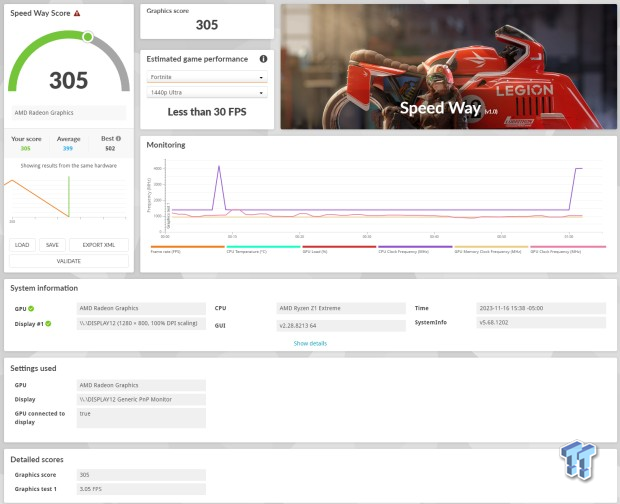
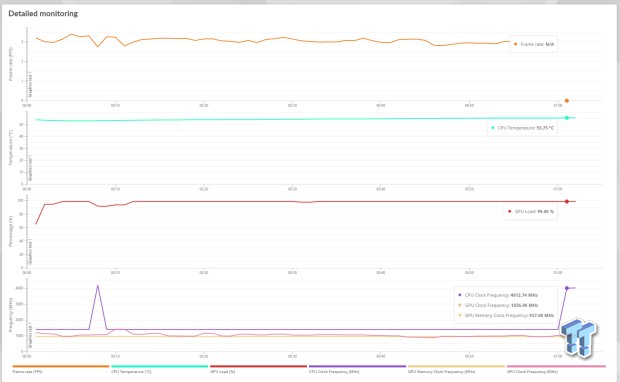
Time Spy
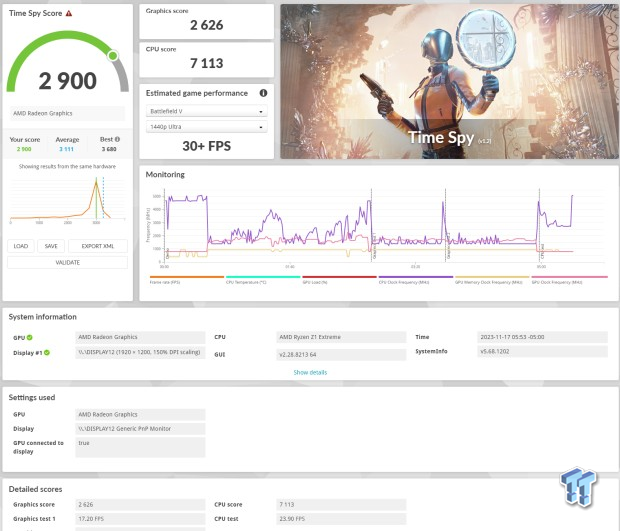
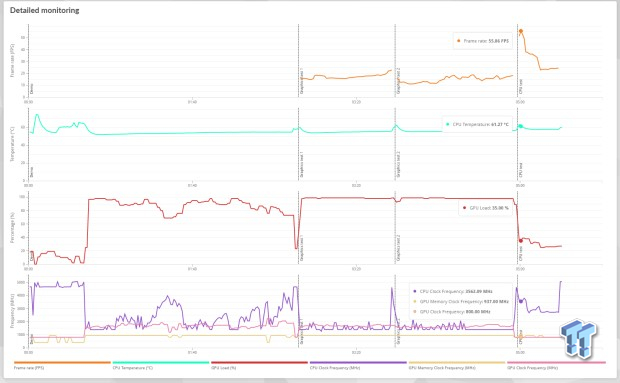
Time Spy Stress Test
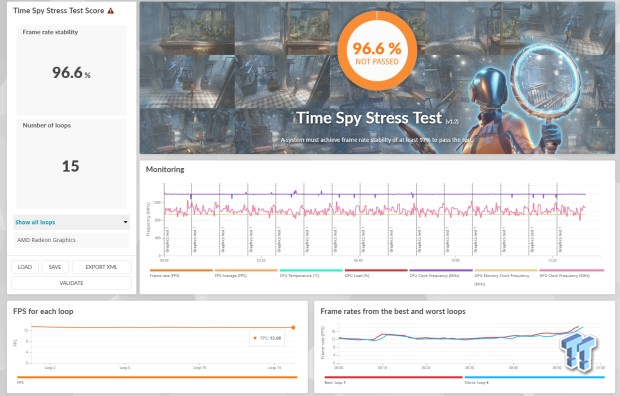
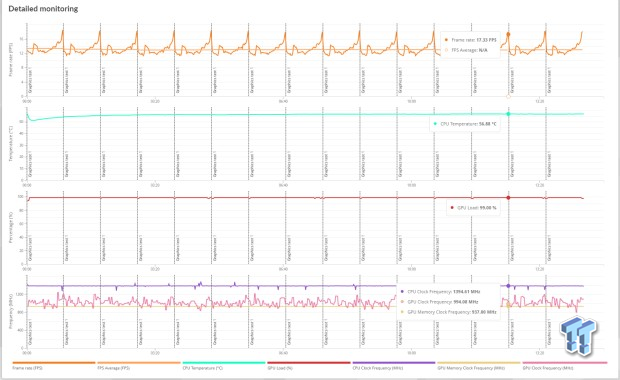
Battery & Temps
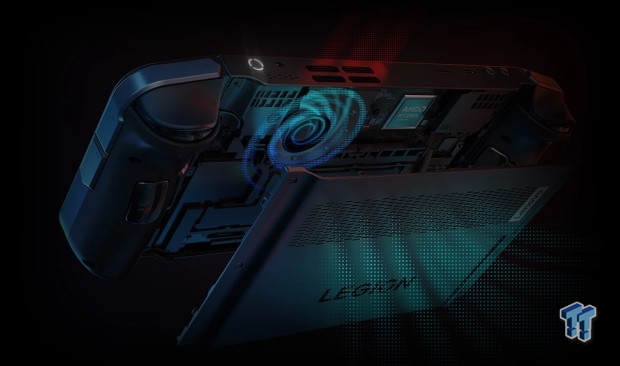
The Legion Go's battery life is pretty decent, delivering around 2 hours of solid playtime. How much battery life you get depends on screen brightness, the demands of the game, and overall graphics and performance settings.
The handheld actually delivered little over 90 minutes of constant play at max brightness, 2560x1600 resolution, and High settings in Starfield.
1280x800
- Mix of games at Low preset
- 25-30% brightness
- 2 hours, 19 minutes
1920x1200
- Mix of games at Low preset
- 25-30% brightness
- Performance - Efficiency configuration
- 1 hour, 57 minutes
2560x1600
- Starfield at High preset
- 100% brightness
- Performance - Performance configuration
- 1 hour, 35 minutes
Temps were likewise solid. The Legion Go expels heat in all the right places, and the thermal system is pretty good at keeping things cool.
Below, we have a few FLIR pictures of the Legion Go's outtake vents. Surface temperatures via thermal imaging were around 50-54C during load, even with the more demanding games like Far Cry 6.
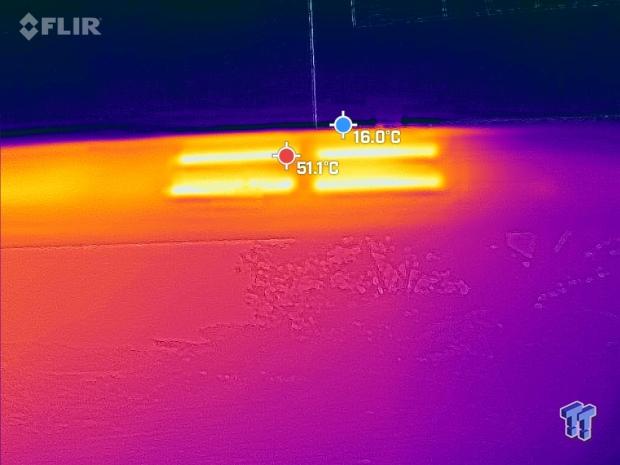
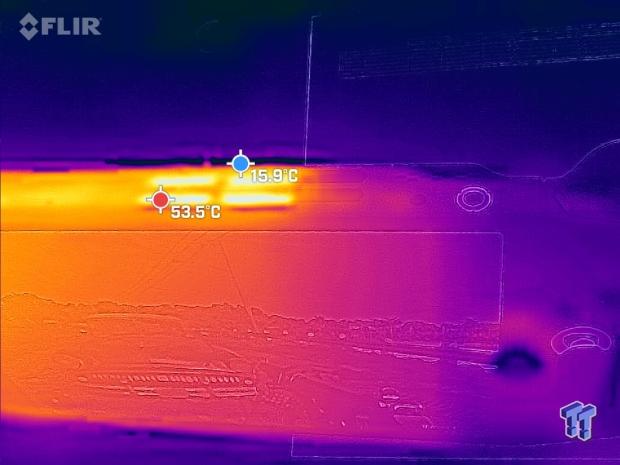
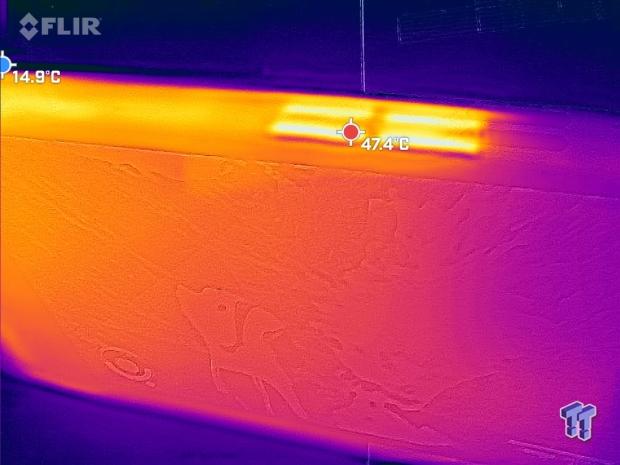
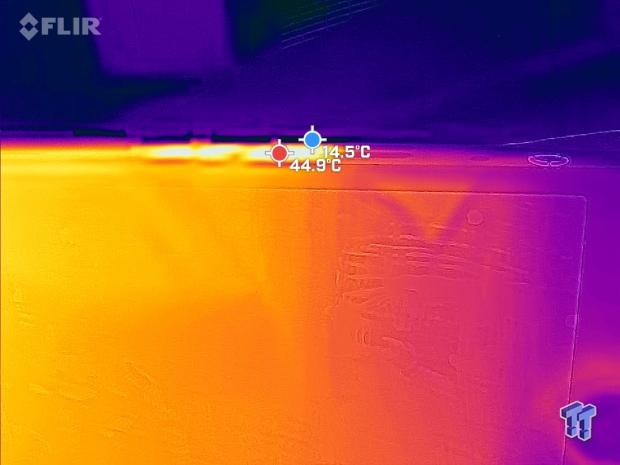
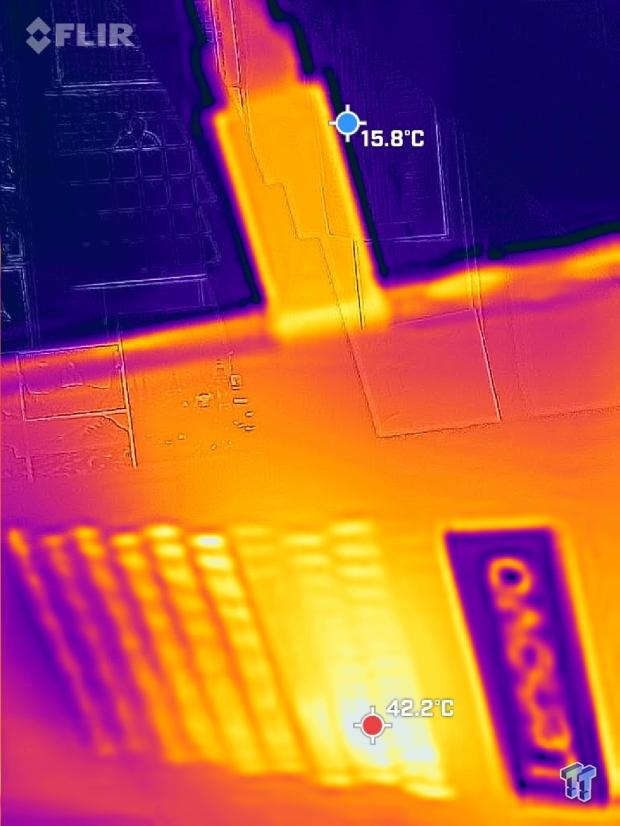
Controllers & Screen
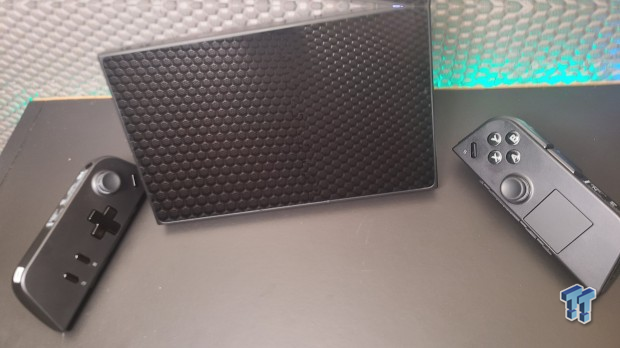
Apart from the processing power and the impressive screen, the controllers are a big selling point of the Lenovo Legion Go. In my experience, the controller's extra buttons are the system's most consistently enjoyable and useful feature.
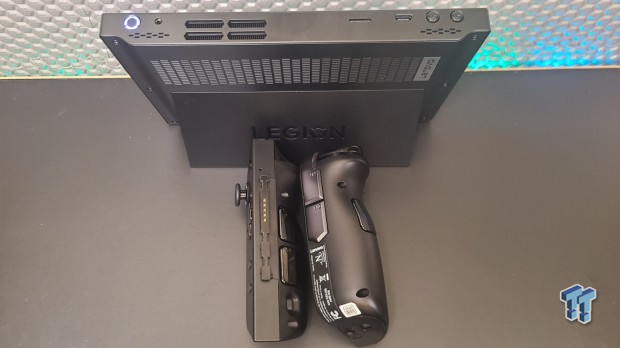
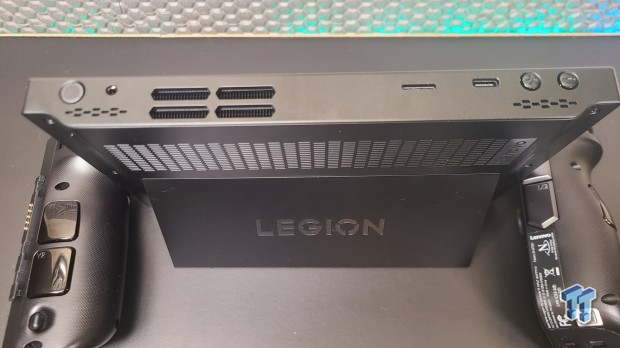
Unlike competing devices, the Legion Go takes a page from Nintendo's playbook with its detachable controllers. There are two controllers, one on either side of the tablet, that pop off for tabletop play.
The Switch has taught us that tabletop play is a must-have for any handheld. Lenovo took this lesson to heart by significantly upgrading the controllers and drastically increasing dual-hand play (one controller in either hand) in the process.
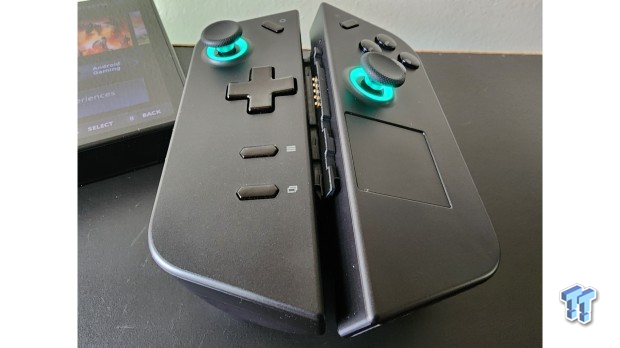
This really comes down to two things: the feeling and functionality of each controller.
The controllers are hefty, they're much bigger than the Switch JoyCons, and they fit in your hands very well. The controller feels like it's designed for adults, more like a PS5 or Xbox controller. It has a certain level of weight to it that's satisfying, and it's not overbearing. A lot of the satisfying feeling comes from how the buttons and triggers are placed on each of the split handhelds.
Now, let's talk about the buttons. This is where things start to get really interesting.
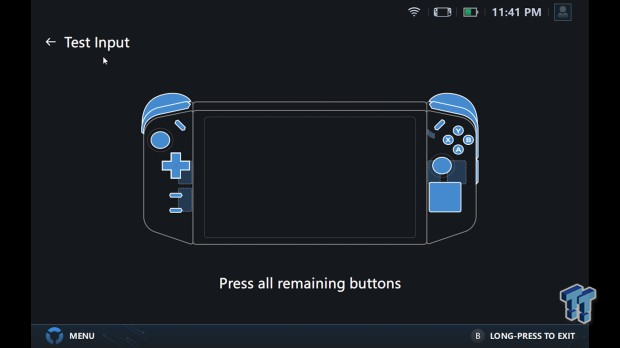
I'm an average gamer who typically uses the default controller when I play games. Just hand me a DualSense or even a more basic PowerA controller, and I'm fine. I haven't owned the higher-end DualSense Edge or Xbox Elite controllers. Using the Lenovo Legion Go changed all of that. I'm now a believer in having as many extra buttons on a well-designed controller as possible. It's a literal game-changer.
It's not enough to have extra buttons. Where they're placed, and how they're shaped, matters the most.
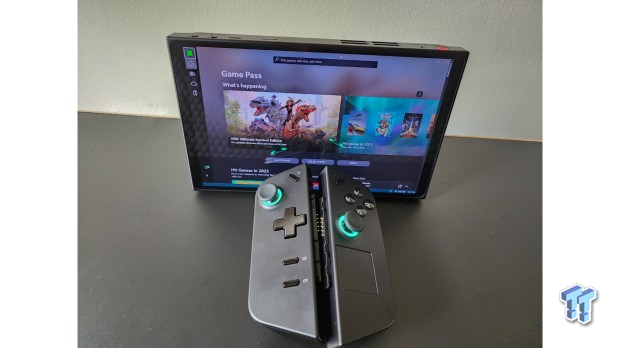
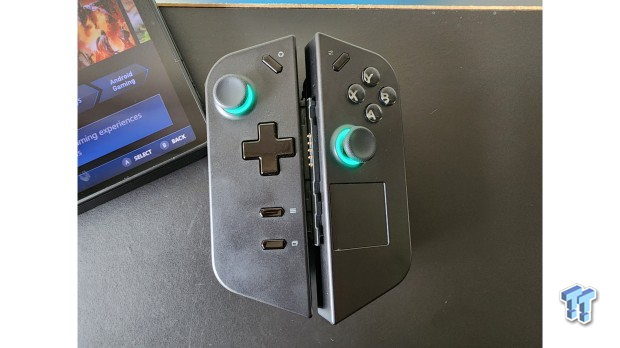
Each of the Legion Go's controllers has different button placements.
The left controller is your standard D-Pad/movement scheme layout, with RT and R1 buttons. It also has a dedicated button for the Legion Go's built-in software suite, which is incredibly convenient if you ever need to adjust more specific parameters and settings (like, for instance, running controller diagnostics tests).
On the underside of the controller there are two extra buttons. These are specifically designed to serve as functional touchpoints for your fingerpads when holding the controller. The buttons are placed vertically, aligning perfectly with your fingers while holding the device.
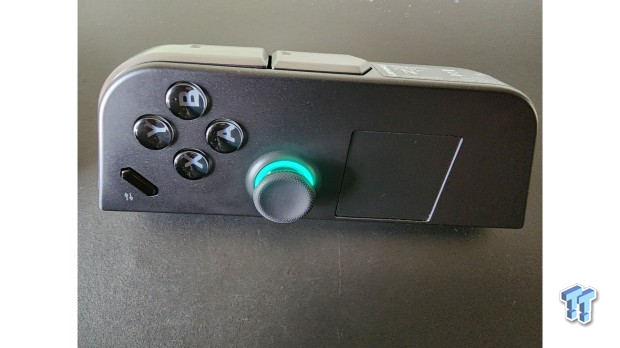
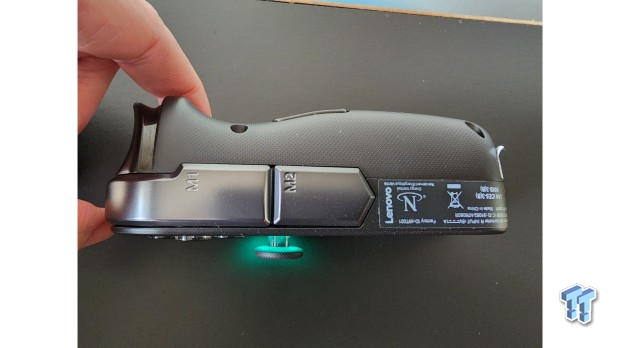
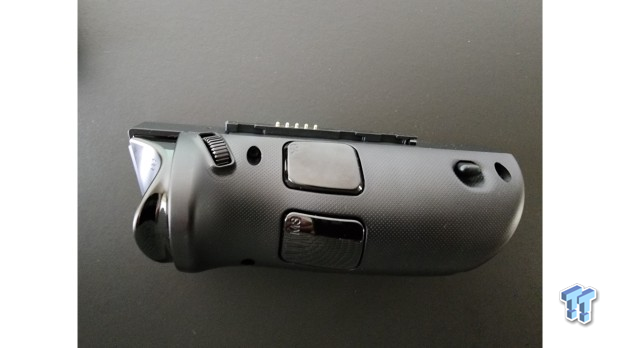
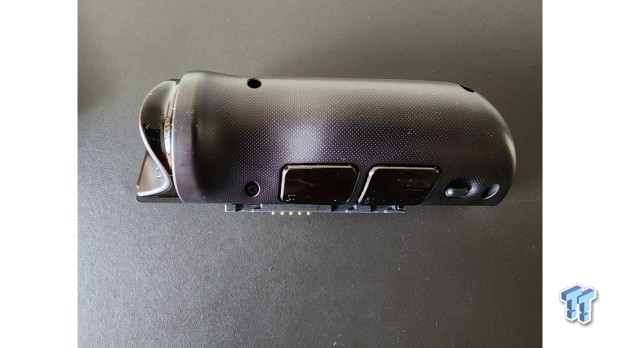
The right controller is my personal favorite. It has a built-in trackpad, which is absolutely required to navigate the tiny Windows menus. It also has a dedicated settings quick launch button that allows you to easily change performance settings and resolution on the fly.
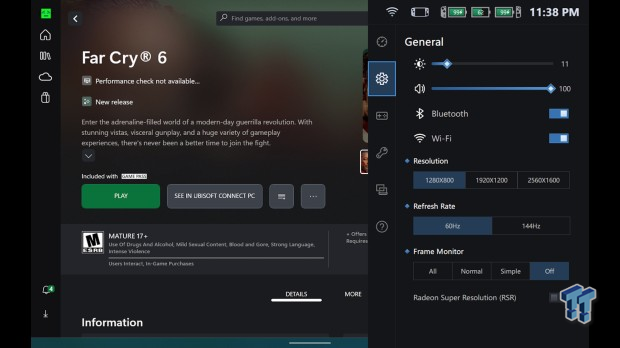
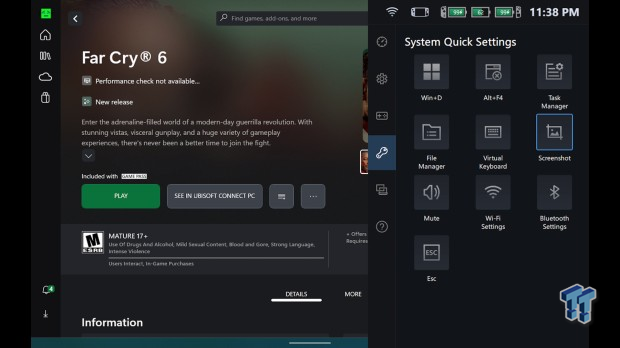
The buttons are the best part, though. The right side has four extra buttons on it (well, five if you include the scroll wheel): There are the M1 and M2 buttons on the side of the controller and the M3 and Y3 buttons on the underside.
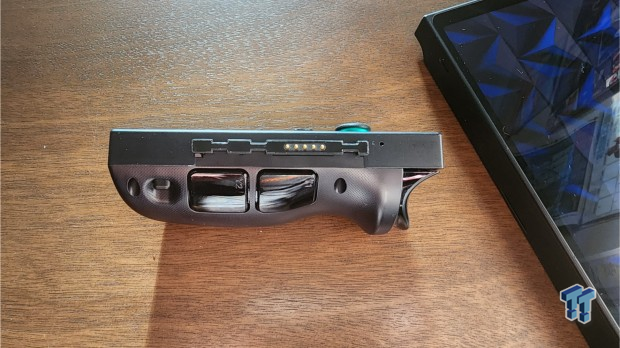
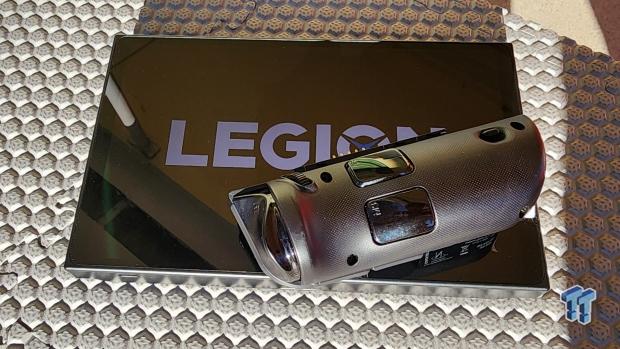
Placement is only as important as functionality. Luckily, gamers can fully re-program and custom map these buttons. For instance, I custom map Y3 to reload when playing shooters, making it so that I don't have to take my thumb off the right analog stick to press X.
This makes the Legion Go an incredibly customizable device that can add a new dimensionality to gameplay experiences. Being able to map simple commands like "jump" or "use" to the Y1 and Y2 buttons has drastically improved my experiences. It's not the button mapping that's new-it's the buttons themselves, and the way they're used.
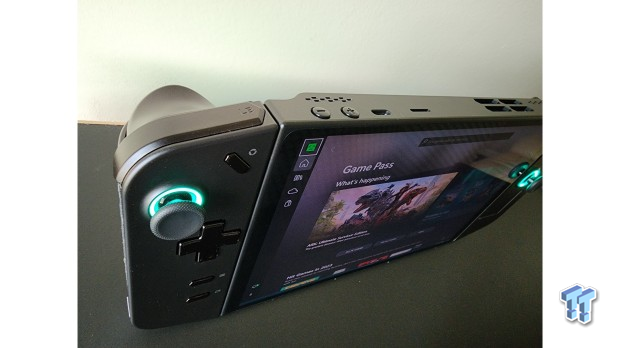
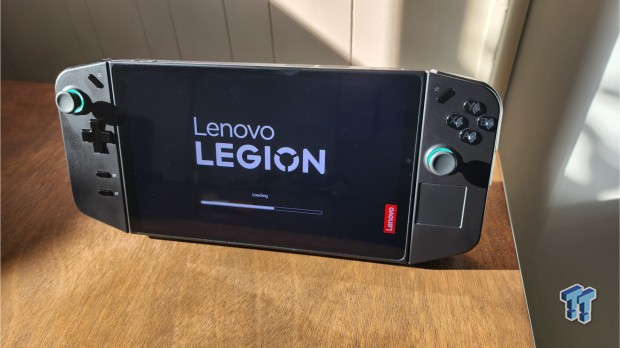


The Legion Go's screen is an impressive 8.8-inch QHD+ IPS display that's big, bold, and beautiful. Gameplay visuals are crisp and clear, colors are vivid, and the screen is enjoyable to look at and interact with.
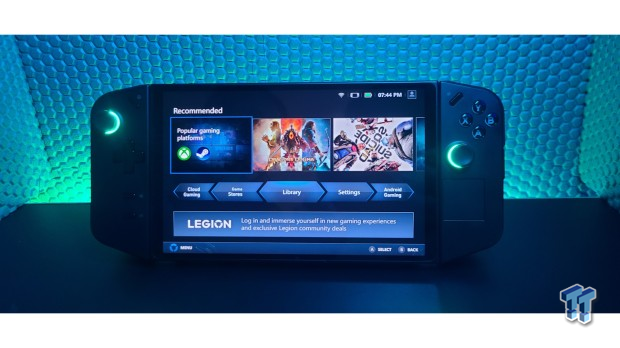
It has a touchscreen that's sensitive enough to pick up light touches, which is great if you want to use a stylus to interact (Windows 11 can be finicky to use on a small screen). The panel supports both 60Hz and 144Hz, although the latter really isn't needed, especially with the Go only pushing 30-50FPS in most games.
Overall, the screen is a consistent reminder of the Go's premium quality.
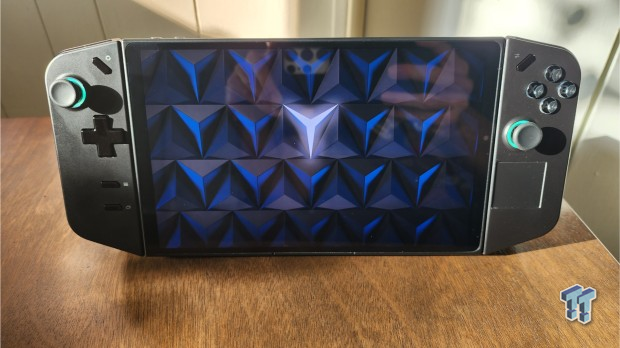
Final Thoughts
The Legion Go is on the higher end of portable gaming, handily beating the Nintendo Switch and matching the ROG Ally. It's a handy, capable, and surprisingly customizable device that also has the benefit of being a fully-fledged Windows 11 PC--that means a full suite of apps and programs that you'd find on a desktop.
The Go is a hefty beast of a handheld that combines versatility, power, and a thoughtful design in one. This is the forefront of a new era in PC-handheld hybrids and the Legion Go leads the charge.
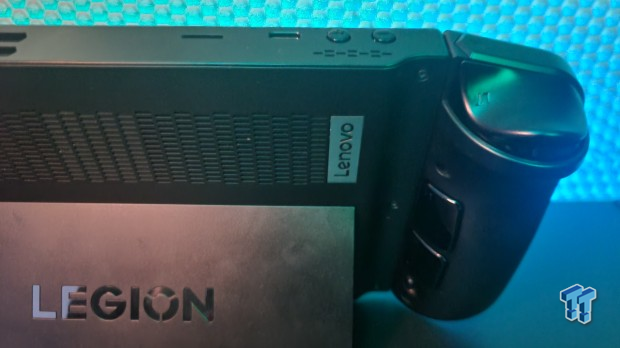
Things I loved about the Legion Go
The kickstand - The Legion Go's kickstand is fantastic. It's less of a stand and more of an extension of the handheld's back panel. The stand spans the entirety of the device's width so it's pretty well reinforced. It's a stark contrast to the wobbly and rickety shakiness of the kickstand in the OG 2017 Nintendo Switch launch model. Lenovo designed the stand to be tough and durable, and it won't buckle or flimsily yield under pressure. This is incredibly an incredibly important addition that protects the Legion Go with a stable base when you're playing in tabletop mode.
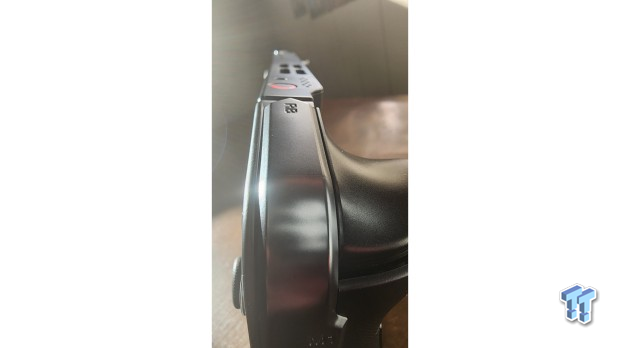
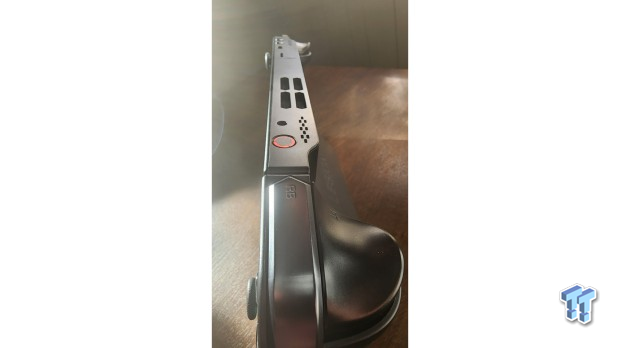
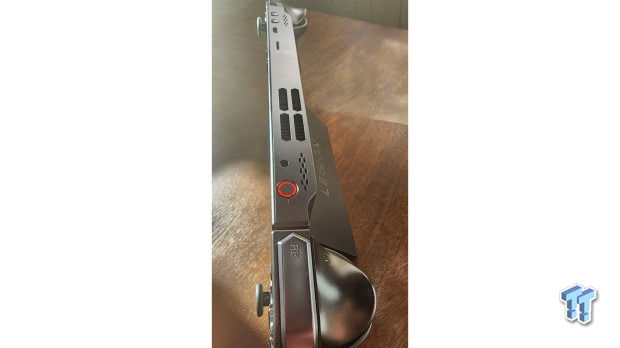
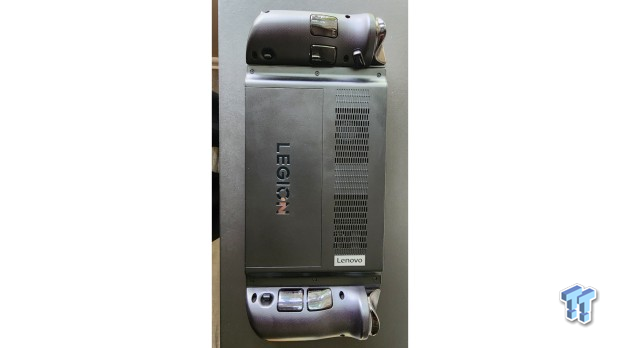
The controllers - The unique button layout coupled with the flexible, split design makes the controllers interesting and fun to use.
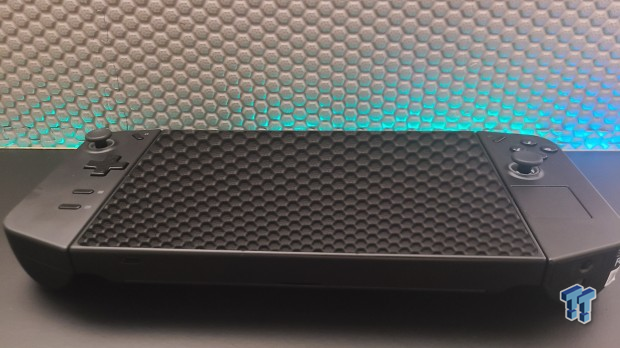
The screen - You'll be staring at this the entire time, so a high-quality screen is important for any handheld. Lenovo delivers beyond the mark here, and the 8.8-inch panel looks fantastic at any brightness.
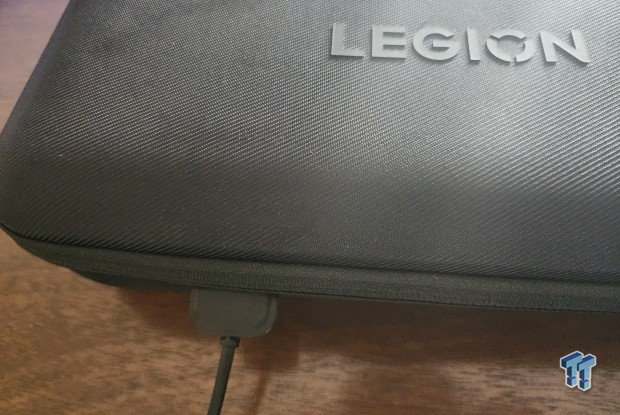
USB Ports & Case - I love the top and bottom USB-C ports, allowing you to use a dongle or other series of peripherals while the system is charging. The case is super reinforced and even has a neat little hole with a flap that lets you charge the Legion Go while safely ensconced in its shell casing.

Complaints
At no point did I face anything that was truly deal-breaking with the Legion Go, but given it's a PC, the handheld is prey to all of the major frustrations of PC gaming. Expect to spend a lot of time tweaking software, setting things up, experimenting, and overall being ready to troubleshoot at a moment's notice.
The Legion Go is a great device, but it's not immune to the annoyances and meticulous, finicky nature of enthusiast PC building/operating/maintenance.
The screen would often refuse to turn back on after the device went to sleep. Analog sticks would light up, but the screen wouldn't turn on.
On-screen keyboard pops up when playing games
Pressing the left analog stick button would cause a virtual keyboard to pop up while gaming. It's a nice feature to have when not gaming, but absolutely interrupts gameplay because that's the stick needed for sprinting in tons of video games.
This problem had nothing to do with the hardware. The problem was tied to Steam's controller settings and required adjustment of the joystick settings.
Had a difficult time capturing screenshots/footage while docked
The Lenovo Legion Go didn't play all that nicely with my Elgato capture card. I hooked up the Legion Go to the capture card via a third-party USB-C to HDMI dongle, and the image was frequently warped. For some reason, the Legion Go output a sideways screen when transmitting video to my Elgato capture card. I managed to fix this by turning the rotation lock on and off in Windows display settings.
Size Comparisons
